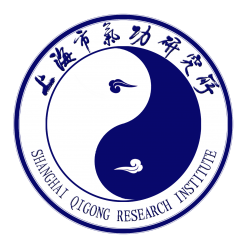Online Dictionary of Common Qigong Terminology

Qigong is the study and practice of body-mind exercise. It is deeply rooted in traditional Chinese medicine, philosophy and health cultivation. Today, the concept of qigong covers a wide variety of health cultivation forms. These include Dao Yin (Guiding & Stretching), Tu Na (Exhalation and Inhalation), Jing Zuo (seated meditation), Guan Xiang (insight meditation), Nei Dan (internal alchemy), Chan Ding (Samatha in Sanskrit, practice of calming of the mind) and Xing Ming Shuang Xiu (dual cultivation of inherent nature and life endowment), etc. With its traditional health cultivation theory and distinctive effects on body and mind, qigong healing is now attracting worldwide attention.
A total of 199 common qigong terms were initially screened by the staff at Shanghai Qigong Research Institute. Upon expert interviews, questionnaire survey and statistical analysis on word frequency, 178 terms were included in this Collections of Qigong Glossary. We believe English translations of these common qigong terms can help with international exchange on qigong education and research and contribute to standardization of qigong terminologies.
- Abdominal Breathing
Abdominal breathing is a breathing that is deep down to the periumbilical region. This breathing is marked by the expansion of the abdomen. It includes normal abdominal breathing and reversed abdominal breathing.
腹式呼吸 【fù shì hū xī】
指呼吸深达脐腹,腹部随着呼吸起伏运动的呼吸形态。腹式呼吸常见的有顺腹式呼吸、逆腹式呼吸。
- Bathing
Originated in Daoism, it refers to ① body-mind cultivation. ② a technique in a certain phase of qigong practice, i.e., a technique to temporarily stop the low of genuine qi during its circulation along the Du and Ren channels. This technique can guide qi using mind-intent to cultivate one’s body and mind.
沐浴 【mù yù】
① 指身心修养。② 指练功到某一阶段应掌握的火候,即真气发动沿任督脉运行时,暂时停止以意引气,休养身心。源于道家。
- Bathing the Face
It’s also known as ‘rubbing the face’, ‘wiping the face’ and ‘dry cleaning of the face’. Method: Rub both hands until they become warm. Put the hands over the lower part of the face and place the middle fingers on bilateral Yingxiang (LI 20). Then rub upwards, pass through Jingming (BL 1) and Cuanzhu (BL 2) and reach the anterior hairline. After this, separate two hands to rub the frontal angles (temples). Finally, rub downwards, pass through Ermen (SJ 21) and return to the lower part of the face.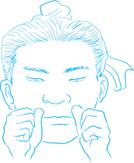
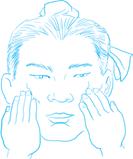
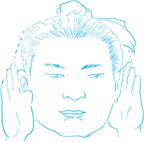
浴面 【yù miàn】
又称摩面、擦面、干洗脸等。方法为:双手擦热,贴在面下部,两手中指分别放在鼻翼两侧迎香穴处,向上推擦,经睛明、攒竹至前额发际处,然后两手分开推擦至额角后而下,经耳门穴而返回下面部。
- Beclouded Mind
Originated in Buddhism, it refers to the sensation of confusion, drowsiness and falling. Confusion and ignorance may lead to abyss of misery.
昏沉 【hūn chén】
源于佛家。指昏钝沉坠的状态,即神识昏钝,懵然无知,不加精进之功,如沉坠苦海一般。
- Being Possessed
This refers to mental disturbances and abnormal psychological reactions resulted from qigong practice. In Chinese, the second word ‘mo’ literally means devil, referring to illusionrelated mental confusion, mania, insanity or psychosis due to harmful mental state or errors in refining the self. It may also occur as a result of fear or panic. In addition, it might be associated with one’s life experience, temperament and predisposing factors.
入魔 【rù mó】
指练功引起的精神活动障碍和心理异常反应。基于不良心理状态或炼己不纯,在练功中产生幻境,对之信以为真,而至神昏错乱,躁狂疯癫,甚至引起精神障碍,就是入魔。既有因惊怖惶恐而造成,也有与人们的各种自身经历、精神意志等诱发因素有关。
- Bodily Cultivation
Originated in Daoism, it refers to the exercise to nourish the body and refine qi.The Complete Works of Master Qiu(aka Zuo Qiu-ming[1]) states,‘Explicit physical movements nurture your body and implicit cultivation of inherent nature nurtures your spirit’.
[1] Zuo Qiu-ming was a court writer of the State of Lu, and contemporary of Confucius during the Spring and Autumn Period. The influential historical text Zuo Zhuan (Commentary of Zuo) is traditionally attributed to him.
命功 【mìng gōng】
源于道家。指修命之功,即养身炼气的功夫。《丘祖全书》:“有为功夫命功也,无为妙道性学也。”
- Body Breathing
This refers to the level of mind-breathing interdependence during qigong practice. It is called body breathing because it appears that the breath freely flows in and out of the body.
体呼吸 【tǐ hū xī】
指练功中心息相依,达到气息在身体出入的境界。
- Bottom of the Sea
It refers to the perineum.
海底 【hǎi dǐ】
指会阴部。
- Breath
In Daoism, it refers to respiration — a cycle of breathing in and breathing out. In Buddhism, it refers to a specific phase of breathing for meditation. See ‘stillness and rest (xī xiāng)’.
息 【xī】
息有两种,道家指呼吸,“一呼一吸谓之息”;佛家指息相,见“息相”条。
- Breath Counting
This refers to counting the breath in qigong practice. It is a common method to help tranquilize the mind by replacing the ten thousand thoughts with one single thought.
数息 【shǔ xī】
指练功中默数呼吸的次数,是一种常用的,以一念代万念来帮助入静的方法。
- Breath-Counting Contemplation
Originated in Buddhism, it refers to counting the breath silently to stop mental distractions. It is one of the five meditation methods.
数息观 【shǔ xī guān】
源于佛家。指默数呼吸的出入,以停止心意散乱的一种观法,为五停心观之一。
- Breath-holding
Also called ‘qi holding’, it refers to stop breathing after inhalation by self-control to prolong the inhalation.
闭息 【bì xī】
又称闭气。指吸气后停闭呼吸,有延长吸气之效。
- Breathing with Lifting Up the Anus
One of the breathing methods during qigong practice: contract and lift up the anus during inhalation and relax the anus down during exhalation.
提肛呼吸 【tí gāng hū xī】
气功呼吸锻炼的一种方法。指在吸气时收摄肛门向上,呼气时放松肛门向下。
- Buoyancy Sensation
One of the eight physical sensations originated in Buddhism: a buoyant sensation like a piece of cloud flying high up in the sky.
轻触 【qīng chù】
源于佛家。八触之一,指感觉身轻如云,好像在天空中飞行一样。
- Chair-Sitting Posture
A common sitting posture for beginners: To sit on the front 1/3 of a stool or chair and do not sit inclined to the back. Make the head, neck and spine upright, and hollow the chest. Also make sure that the knees maintain 90-degree angles. Place both hands naturally on the laps.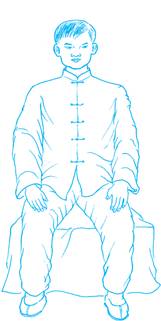
平坐式 【píng zuò shì】
一种初练坐式时常用的练功姿势。要求坐在方凳或硬椅上,以坐前 1/3 为宜,后背不靠,头正颈直,竖脊涵胸,大小腿间呈 90°直角,两手自然放置腿上。
- Circulation of Qi
Also known as ‘ingestion of qi’, ‘refining of qi’ and ‘intake of qi’, it refers to inhaling and exhaling exercise. Sometimes it may refer to guide and lead internal qi to flow.
行气 【xíng qì】
又称服气、炼气、食气。指呼吸吐纳锻炼;也指导引与内气运行。
- Climbing for Dependent Origination
Originated in Buddhism, it refers to the arising of consciousness due to its contact with the external world. In qigong practice, it specifically refers to the mental function of cognizing perception or scenes.
攀缘 【pān yuán】
源于佛家。原指身心随外界事物纷驰而多变。练功中专指心神贪求、攀附某种感受或景象。
- Coldness Sensation
One of the eight physical sensations originated in Buddhism: a sensation that the body feels as cold as ice.
冷触 【lěng chù】
源于佛家。八触之一,指感到身冷如冰。
- Combined Exercise with Nourishment
In Chinese, the first word ‘lian’ means exercise of regulating the body, breath and mind. The second word ‘yang’ means to relax, recuperate and nourish essence, qi and spirit during exercise or in daily living. Exercise can invigorate the circulation of qi. Nourishment can help to supplement qi and nourish spirit. Some people consider that active or dynamic physical movements (Dong Gong)are attributed to exercise, whereas static meditation (Jing Gong) to nourishment.
练养相兼 【liàn yǎng xiāng jiān】
练,指调身、调息、调心的功法锻炼。养,指功法锻炼过程中一定的放松与调养;平时生活中对精气神的调养。通过“练”促进气机有序运行,间以“养”有益积精累气养神。也可将动功归于“练”,而静功归于“养”。
- Combined Motion and Stillness
In Chinese, the first word ‘dong’ (motion) means movements of the body and internal breathing (sensation): movement of the body is understood as ‘external movement’, whereas movement of breathing as ‘internal movement’. The second word ‘jing’ (stillness) means tranquil of the body and mind: tranquil of the body is understood as ‘external tranquil’, whereas tranquil of the mind as ‘internal tranquil’. This term contains two aspects. One is the close combination of static qigong and dynamic qigong; the other is ‘stillness in motion’ and ‘motion in stillness’ during qigong practice.
动静结合 【dòng jìng jié hé】
动,指形体外部和体内“气息”(感觉)的运动,前者可视为“外动”,后者可视为“内动”。静,指形体与精神的宁静,前者可视为“外静”,后者可视为“内静”。一方面指在练功方式上强调静功与动功的密切结合;另一方面指在练动功时要掌握“动中有静”,在练静功时要体会“静中有动”。
- Coming out of Meditation
Originated in Buddhism, it refers to coming out of the state of meditation and return to a normal state.
出定 【chū dìng】
源于佛家。指从禅定状态恢复至常态。
- Concentrated Meditation
This term is originated in Buddhism.
1. The Chinese translation of the Sanskrit terms Dhyana, meaning deep contemplative practice or absorption. ① Mundane meditation: the four Dhyanas on the form-realms and the eight concentrations, i.e. four on the form realms and four on the formless realms. ② Supra- mundane meditation: the three vehicles that carry living beings across mortality to the shores of nirvana.
2. According to the Platform Sutra of the Sixth Patriarch (Liu Zu Tan Jing)[1], the first word ‘chan’ means the mind being free from the limitations of the body; The second word ‘ding’ means still and quiet mind.
[1] It is a Buddhist scripture that was composed in China during the 8th to 13th century.
禅定 【chán dìng】
源于佛家。
1. 梵语禅那,华译为禅定,略有二种:① 世间禅,如色界无色界之四禅八定。② 出世间禅,如三乘行人所修之禅定。
2. 禅与定。修行时外离一切相,叫做“禅”,内心性不乱,叫做“定”。《六祖坛经》:“外离相为禅,内不乱为定。”
- Contemplation of the Mind
Originated in Buddhism, it means to observe the nature of the mind. Since the heart (mind) is the root of all things, observing the mind means observing all things. Seeking truth in all things can therefore be called contemplation of the mind.
观心 【guān xīn】
源于佛家。指观察心性。心为万法之主,无一事能漏于心,故观察心,即观察一切。因此,凡究事观理,都可以称为观心。
- Contemplation on the Void
Originated in Buddhism, it can mean ① Contemplation on the void of all existence, involves moving from the world of provisionality to the world of emptiness. ② One of the three meditations (void, unreal and mean) in one mind devised by the Tiantai School[1].
[1] It’s an important school of Buddhism in China, Japan, Korea, and Vietnam, revering the Lotus Sutra as the highest teaching in Buddhism.
空观 【kōng guān】
源于佛家。① 对空谛的观想。空谛即诸法之自性本空,以体认无相为宗。② 指天台宗所立一心三观(空观、假观、中观)之一。
- Crimson Palace
Originated in Daoism, it refers to the middle Dan Tian below the heart.
绛宫 【jiàng gōng】
源于道家。指心下中丹田。
- Cross-Legged Posture
Also called natural or tailor sitting, it’s a sitting posture of putting the two legs crosswise on the underside of the body.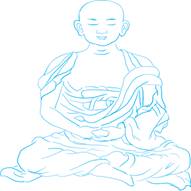
自然盘 【zìrán pán】
又称散盘。指练功姿势中坐姿的一种,即两腿自然交叉坐于地上。
- Dao Yin
According to commentaries to Zhuang Zi Ke Yi (Cultivating One’s Willpower, Zhuang Zi) by Li Yi in the Jin dynasty (265-420), this term means to guide qi to harmonize the body and stretch the body to make it soft. This method aims to prevent diseases and promote health through stretching exercise combined with breath and internal qi circulation.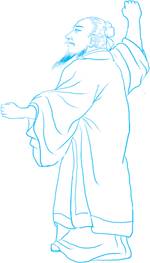
导引 【dǎo yǐn】
晋代李颐注《庄子· 刻意》:导气令和,引体令柔。现指按照一定规律和方法进行的肢体运动、呼吸吐纳及内气运行,用以防病保健的练功功法。
- Dao Yin for the Five-Zang Organs
This dynamic exercise method aims to treat problems of the five-zang organs. It was first recorded in the Illustrations of Reinforcing and Reducing the Five-Zang and Six-Fu Organs in the Internal Illumination of the Yellow Court (Huang Ting Nei Jing Wu Zang Liu Fu Bu Xie Tu).
五脏导引法 【wǔzàng dǎoyǐnfǎ】
指以动功为主,专用以治疗某些五脏疾患的导引功法。最早见于《黄庭内景· 五脏六腑补泻图》。
- Daoyin Diagram
A diagram for daoyin exercise. ① In 1973, the Daoyin diagram painted on silk unearthed from Tomb No.3 at Changsha Mawangdui was the oldest (the Western Han dynasty: 206BC-24CE) extant painting on Daoyin. Originally this silk painting has no name. The accompanying captions of each figure performing Daoyin postures were later added by the task team sorting out silk books unearthed at Mawangdui Han Tombs. ② The Treatise on the Classics and Compilations in the Book of the Sui Dynasty (Sui Shu Jing Ji Zhi) states, ‘There are three volumes of Daoyin diagram — One in standing postures, one in sitting postures and one in lying postures’. ③ The Preface to the Daoyin Diagram (Dao Yin Tu Xu) written by Liang Su was first recorded in the Textual Research on Treatise on Literature, the Book of Han (Han Shu yi Wen Zhi Kao Zheng) by Wang Ying-lin, the Chong Wen Bibliography (Chong Wen Zong Mu). It is therefore concluded that this diagram might have been about the people in the Tang dynasty (618- 907) and compiled in the early Song dynasty (960- 1279). ④ There was illustrated Mr. Ning’s Daoyin Health Preservation Method (Ning Xian Sheng Dao Yin Yang Sheng Fa) in volume 34 of the Seven Lots from the Book Bag of the Clouds (Yun Ji Qi Xian)[1]. These illustrations were believed to have been compiled in the Song dynasty but the source was unknown. ⑤ There was one volume of Six Qi Daoyin Diagram (Liu Qi Dao Yin Tu) in the Chong Wen Bibliography. ⑥ There was one volume of Yellow Court Daoyin Diagram on Five- Zang Organs (Huang Ting Wu Zang Dao Yin Tu) in the Chong Wen Bibliography (unfortunately, the texts and illustrations from ② to⑤ were lost). ⑦ There was Jing Shen Fang Shan Daoyin Diagram (Jing Shen Shan Fang Dao Yin Tu) in the Qing dynasty (1636-1911); however, it was not so popular.
[1] It is an anthology of the Daoist Canon, which the scholar-official Zhang Jun- fang compiled for Emperor Zhenzong of Song. The Yun Ji Qi Xian records many early Daoist texts that have been lost since the 11th century, and is an important resource for understanding medieval Daoism.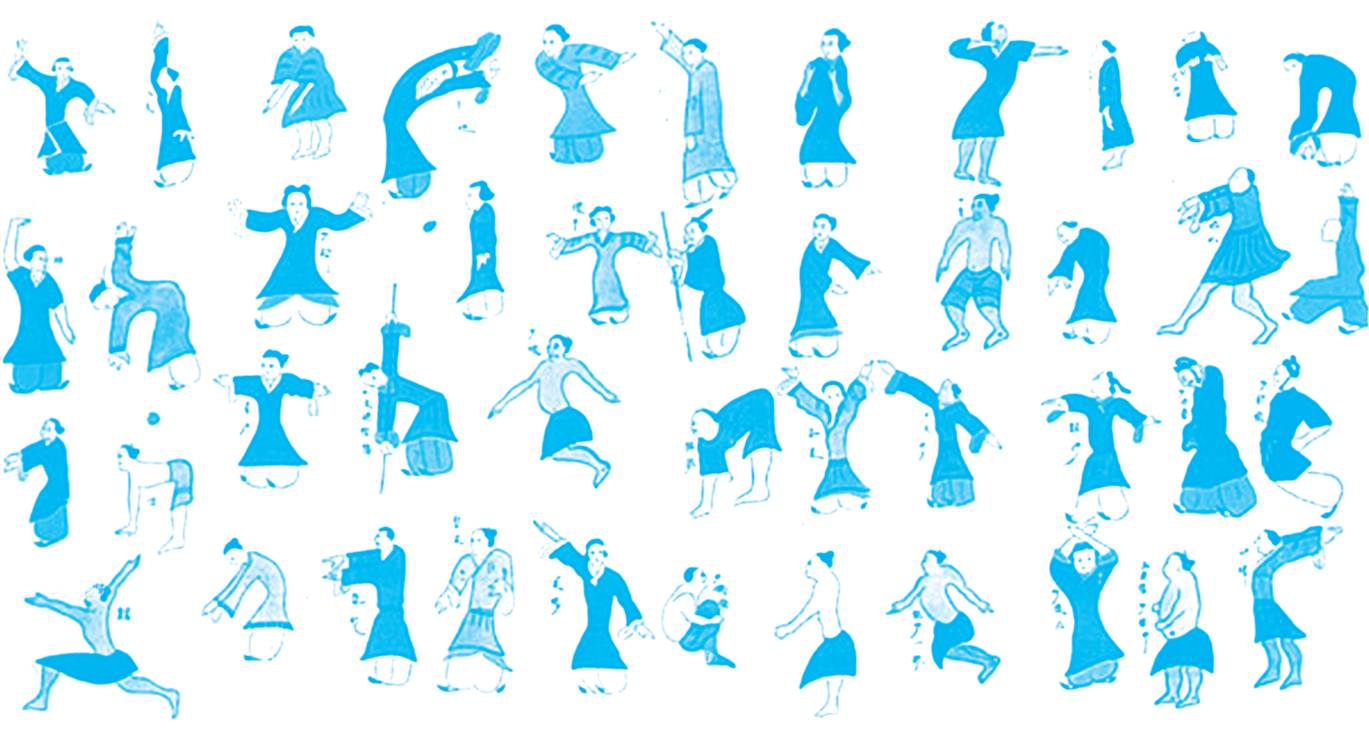
导引图 【dǎo yǐn tú】
导引功法图名称。① 1973 年长沙马王堆三号汉墓出土的西汉初年的帛画,是迄今我国最早的导引图谱。原无图名,现名由马王堆汉墓帛书整理小组拟定。②《隋书 · 经籍志》:《导引图》三卷,原注立一、坐一、卧一。③《导引图序》梁肃作,原载《崇文总目》王应麟《汉书艺文志考证》引文。此图可能是唐人图,系宋初著录。④《云笈七签》卷三十四《宁先生导引养生法》有图。亦系宋画,原出处不详。⑤ 《六气导引图》一卷,见《崇文总目》。⑥《黄庭五脏导引图》一卷,见《崇文总目》。(以上②至⑤皆佚)⑦ 清· 敬慎山房刊有《导引图》,但流传不广。
- Deep and Quiet Breathing
Originated in Buddhism, it means that there are no breathing sounds or obstruction/hindrance in breathing; however the inhalation and exhalation are not even and peaceful.
气相 【qì xiàng】
源于佛家。打坐时气息虽无声亦不结滞,而出入不细。
- Deviation Correction
It means to correct qigong deviations that occur during qigong practice using relaxation exercise, Chinese herbal formula, stimulating body points and Daoyin.
纠偏 【jīu piān】
指运用放松训练、中药、点穴、导引等方法来纠正在练功过程中出现的偏差。
- Dragon and Tiger
It is also called Green Dragon and White Tiger. Green dragon and white tiger are both the four emblematic symbols in ancient Chinese culture. In terms of the five-element theory, the green dragon is a mythical animal representing the East. The direction of the green dragon is east and the season of it is spring. Of the 28 mansions in Chinese constellations, the green dragon represents seven stars of the East ( Jiao-Horn, Kang-Neck, Di-Root, Fang-Room, Xin-Heart,Wei-Tail and Ji-Winnowing Basket). In terms of the five-element theory, the white tiger is a mythical animal representing the West. The season of the white tiger is autumn. Of the 28 mansions in Chinese constellations, the white tiger represents the seven stars of the West (Kui-Legs, Lou-Bond, Wei-Stomach, Mao-Hairy head, Bi-Net, Zi-Turtle Beak and Shen-Three Stars).
The ‘dragon’ and ‘tiger’ have been used in internal alchemy ever since the emergence of Daoism, referring to ‘lead, mercury, Kan-water, Li-fire, yin and yang’. In internal alchemy, the dragon is correlated with yang and the trigram Li-fire, thus resulting in the saying ‘Dragon emerges from fire’; while the tiger is correlated with yin and the trigram Kan-water, thus resulting the saying ‘Tiger lives close to water’. The unity of the dragon (yang) and tiger (yin) can be understood as harmony between yin and yang, i.e., the root of primordial spirit or essence. In another theory, the inherent nature (xing) is compared to the green dragon because it’s correlated with the wood, east and trigram zhen-thunder, whereas the sentiment or passions (qing) is compared to white tiger because it’s correlated with the metal, west, trigram dui-lake and the color white. Since the metal counteracts wood, the passions may damage the inherent nature. The goal of internal alchemy is to perfectly unite the two through true essential qi. In human body, the liver is dragon and the kidney is tiger. In terms of external alchemy, the dragon (yang) is lead and the tiger is mercury.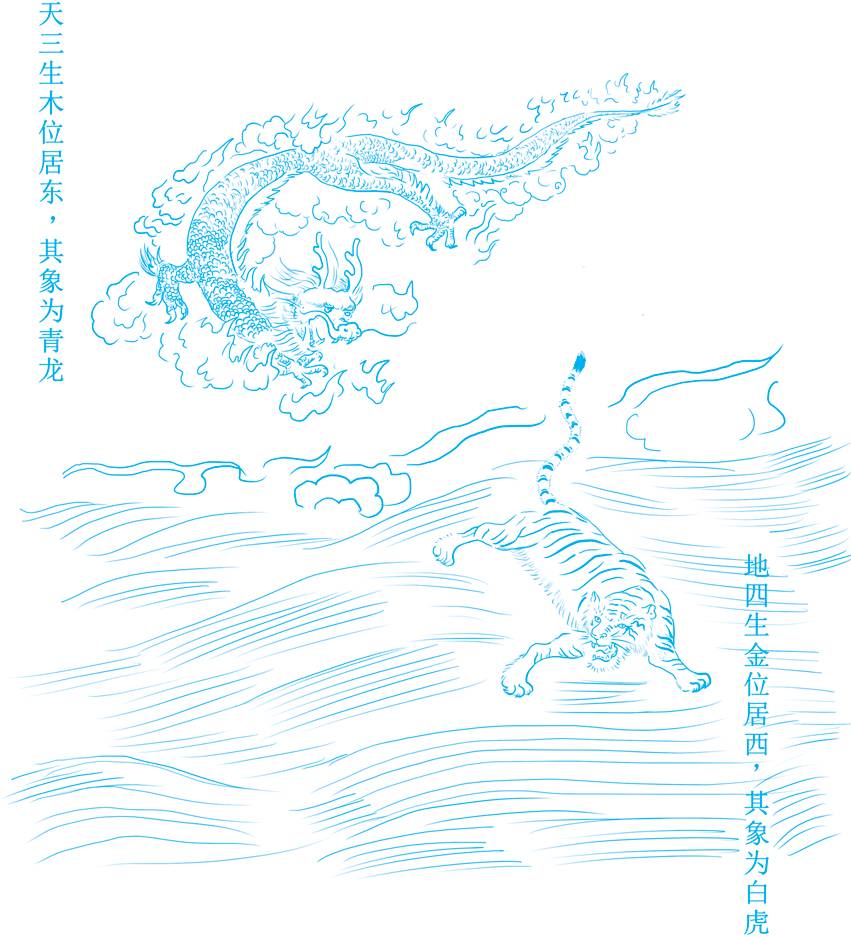
龙虎 【lóng hǔ】
又称青龙白虎,是中国传统文化中的象征符号。根据五行学说,青龙代表东方的灵兽,位于东、左,代表春季;在中国二十八宿中,青龙是东方七宿(角、亢、氐、房、心、尾、箕)的总称。白虎代表西方的灵兽,位于西、右,代表秋季;白虎是西方七宿(奎、娄、胃、昴、毕、觜、参)的总称。在道教兴起之后,龙虎被借用为道家炼丹的术语,就是指"铅汞、坎离、水火、阴阳"等的同义词。而道家炼丹分内外,内丹是就阴阳五行而言,龙阳,生于离,离属火,故云“龙从火里出”;虎阴,生于坎,坎属水,故云“虎向水边生”,两者结合之后,一阴一阳,互相调和,称为道本,都是元神、元精的代表。而另外一种说法是,性属木,木代表东方,于卦为震,木青色,故比为青龙;情属金,金代表西方,于卦为兑,金白色,故喻为白虎。金能够克木,故情多损性,而用二八之真精气,使之交合为一,则金木无间,龙虎自伏而成丹。在人体中以肝为龙、肾为虎;而外丹则仍取阴阳之意,以龙为铅,虎为汞。
- Drop the Eyelids
This refers to slowly let the eyelids drop during static qigong practice.
垂帘 【chuí lián】
指练习静功时,双眼睑缓慢地垂下。
- Dual Cultivation of Inherent Nature and Life Endowment
This term is originated in Daoism. In Chinese, the first word ‘xing’ (inherent nature) covers one’s mind, thought, disposition, temperament and spirit. The second word ‘ming’ (life endowment) covers one’s body, life, energy, destiny and material things. Dual cultivation of inherent nature and life endowment can also be understood as body-mind cultivation.
性命双修 【xìng mìngshuāngxiū】
源于道家。性,指人的心性、思想、秉性、性格、精神等;命,指人的身体、生命、能量、命运、物质等。性命双修是指神形兼修。
- Dynamic Qigong
A qigong term as opposed to static qigong, referring to active physical movements in accordance with the circulation of qi and blood. It is characterized by motion in stillness, stillness in motion and combine body, breath and mind into one.
动功 【dòng gōng】
相对于静功而言,指身体外形运动符合气血运行规律,以达到三调合一的功法。特点是外动内静,动中求静,以调身导引为主。
- Eight Physical Sensations
Originated in Buddhism, it refers to eight physical sensations which hinder meditation in its early stage, namely, restlessness, itching, buoyancy, heaviness, coldness, heat, roughness, and smoothness.
八触 【bā chù】
源于佛家。指即将获得初禅定的人,其身上可能发生的八种感触,即动、痒、轻、重、冷、暖、涩、滑。
- Eight Sections of Brocade
A well-known ancient exercise method. In Chinese, the first two words ‘ba duan’ means eight sections and the last word ‘jin’ means precious or valuable. With a history of more than 800 years, the eight sections of brocade have a variety of styles in terms of postures (standing and sitting) and movements (the Southern Sect and Northern Sect). The Southern sect contains soft, easy movements and is therefore known as ‘civil eight sections’. The Northern sect contains strong movements mostly in the horse stance and is therefore called ‘martial eight sections’.Lift the Heavens with Two flands to Regulate Sanjiao; Sway the Head and Shake to Clear Heart-Fire; Draw the Bow both Left and Right-Handed to Shoot the Hawk; Hold the Feet with Both Hands to Consolidate the Kidney and Low Back; Hold One Arm Aloft to Regulate the Spleen and Stomach; Clench the Fists and Glare Angrily to Increase Strength; Look from Side to Side to Prevent Five Overstrains and Seven Injuries; 7 Times of Bouncing to Relieve All Diseases.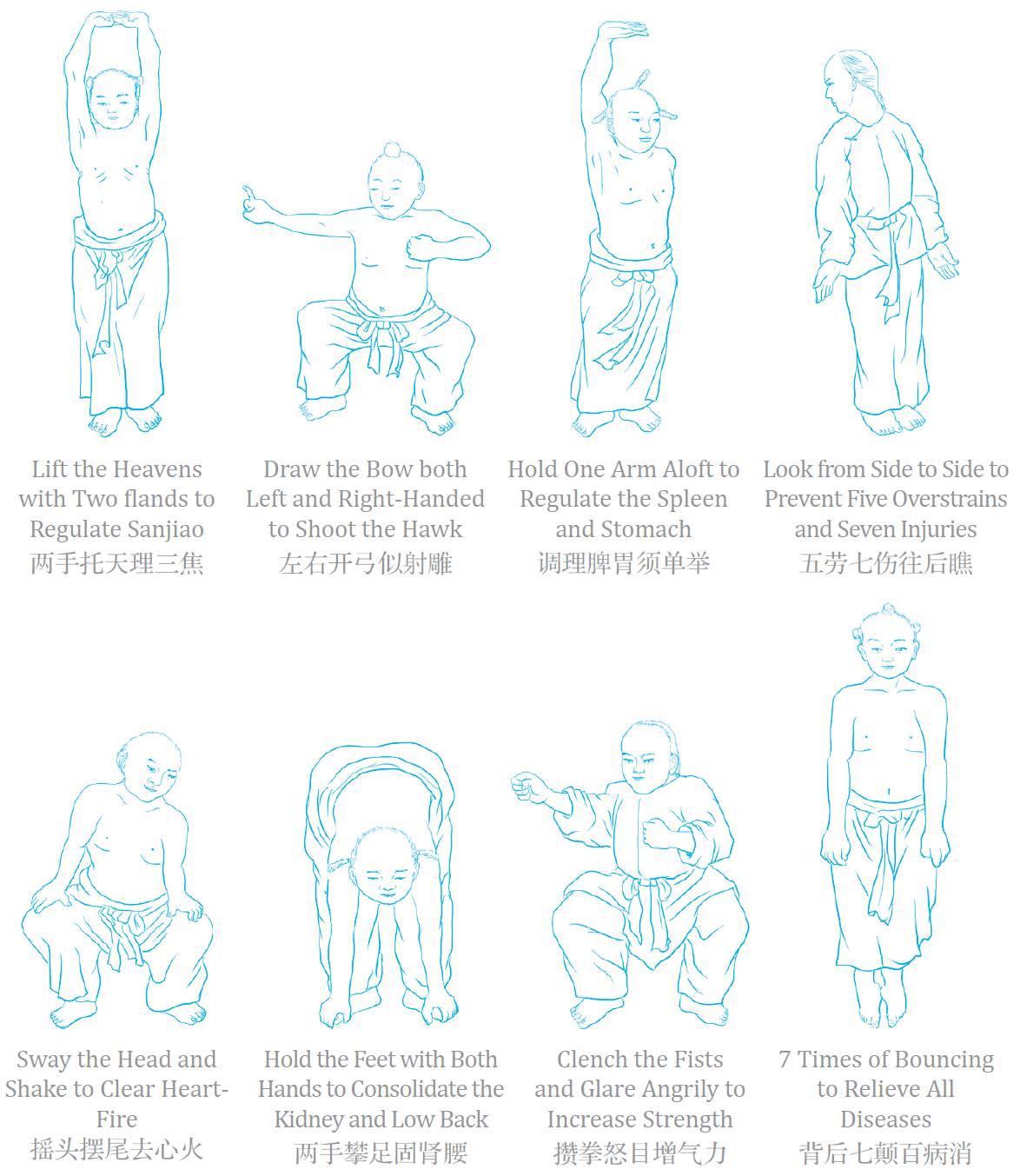
八段锦 【bāduànjǐn】
中国古代著名导引功法。“八段”谓其节数,“锦”谓其珍贵。八段锦已经有八百多年的历史,在历代相传中,形成很多流派,不但在练功姿势上有站式和坐式的不同,而且在动作风格上,也有南派和北派之区别。南派动作以柔为主,法简而易学,又名文八段。北派动作以刚为主,多用马步,术繁而难练,又名武八段。两手托天理三焦;左右开弓似射雕;调理脾胃须单举;五劳七伤往后瞧;摇头摆尾去心火;两手攀足固肾腰;攒拳怒目增气力;背后七颠百病消。
- Eight Trigrams
Eight trigrams are eight fundamental units for natural phenomena in the Book of Changes (Zhou Yi). One trigram includes three horizontal lines, a solid line ‘─’ represents yang and a broken line ‘╌’ represents yin. Each trigram symbolizes a natural phenomenon, respectively Qian(☰) for heaven,Kun (☷) for earth, Kan(☵) for water, Li(☲) for fire, Zhen(☳) for thunder, Gen(☶) for mountain, Xun(☴) for wind and Dui(☱) for lake.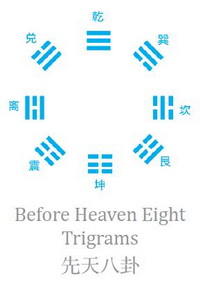
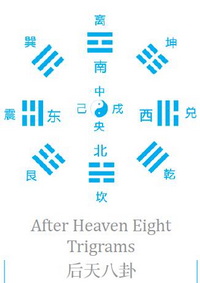
八卦 【bā guà】
指《周易》中象征天道运行和人事变化的八种不同性质类型的八个基本单位。用“─”代表阳,用“╌”代表阴,用三个这样的符号,组成八个单位,叫做八卦。每一卦形象征一定的事物,乾(☰)象征天,坤(☷)象征地,坎(☵)象征水,离(☲)象征火,震(☳)象征雷,艮(☶)象征山,巽(☴)象征风,兑(☱)象征泽。
- Elimination of Five Desires
Originated in Buddhism, it means to eliminate the five desires arising from the objects of the five senses, things seen, heard, smelt, tasted, or touched, which gradually helps the mind to attain tranquil and emptiness.
诃五欲 【hē wǔ yù】
源于佛家。指练功中逐渐祛除色、声、香、味、触等五类欲念,使心灵渐趋恬淡虚无之境。
- Emission of Qi
This means that qigong masters use external conductance of ‘internal qi’ out of the body to treat ailments for other people. This method is now known as ‘external qi healing’. In Chinese, the first word ‘bu’ means to spread or release. This method can be traced back to pre-Qin era.
布气 【bù qì】
指气功锻炼有素者,将自身“内气”发放于体外,并作用于他人而起治疗疾病的作用,即现在所谓的“外气”治病。“布”有传布、布放的意思。布气术自先秦以来,代有传承,可谓源远流长。
- Entering Meditation
Originated in Buddhism, it refers to entering into meditation.
入定 【rù dìng】
佛家术语。指入于禅定。
- Essence
Essence refers to all nutrient substances that can nurture the human body. It is also the essential material foundation of the body. The Discourse on the True Words in the Golden Chamber (Su Wen Jin Kui Zhen Yan Lun) states, ‘the essence is the basis of the body.’ Essence can be categorized as prenatal or postnatal. The prenatal essence is highly important in traditional health cultivation, as quoted in the Preface to the Four hundred words on the Golden Elixir ( Jin Dan Si Bai Zi Xu), ‘Refining the essence means to refine the yuan-primordial essence instead of the seminal essence’.
精 【jīng】
指一切有用的、滋养人体的精微物质,是构成人体的物质基础。《素问 · 金匮真言论》: “夫精者,身之本也。”精可分为先天之精与后天之精两大类,传统养生文化重视先天之精。《金丹四百字序》:“炼精者,炼元精,非淫泆所感精。”
- Exhaling the Stale and Inhaling the Fresh
This refers to exhale the stale (known as Tu in Chinese) and inhale the fresh (known as Na in Chinese) during qigong practice. It is also called the technique of exhaling and inhaling. Ji Kang[1] mentioned in his Essay on Nourishing Life (Yang Sheng Lun) that, ‘Exhaling the stale and inhaling the fresh can nourish life and allow the unity of body and mind’. The outer chapter Cultivating One’s Willpower, Zhuang Zi[2](Zhuang Zi Ke Yi) states, ‘Breathing in and out in various manners, spitting out the old and taking in the new, walking like a bear and stretching their neck like a bird to achieve longevity.’
[1] Ji Kang (223-262) was a Chinese author, poet, Taoist philosopher, musician and alchemist. He was one of the Seven Sages of the Bamboo Grove who engaged in separating themselves from the dangerous political situation of third century China, in favor of devoting themselves to a life of art and leisure.
[2] Zhuang Zi was an influential Chinese philosopher who lived around the 4th century BCE during the Warring States period, a period corresponding to the summit of Chinese philosophy, the Hundred Schools of Thought. He is credited with writing — in part or in whole — a work known by his name, the Zhuang Zi, which expresses a philosophy w hich is sk eptical, arguing that life is limited and knowledge to be gained is unlimited.
吐故纳新 【tǔ gù nà xīn】
练功过程中呼出污浊之气为“吐”,吸入新鲜之气为“纳”,总称“吐故纳新”,也称“吐纳之术”。魏· 嵇康《养生论》:“又呼吸吐纳,服食养身,使形神相寄,表里具济也。”《庄子· 刻意》:“吹呴呼吸,吐故纳新,熊经鸟伸,为寿而已矣。”
- External Qi
This refers to qi manifestedor emitted outward by the true or internal qi.
外气 【wài qì】
指人体的真气或内气,以某种形式出现或外放于身体之外。
- False Thoughts
These refer to false or distracting thoughts during qigong practice.
妄念 【wàng niàn】
指练功中出现的各种虚妄意念。
- Fetal Breathing
Originated in Daoism, it’s also known as breathing with the Dan Tian or umbilicus just like a fetus in a womb. In qigong practice, it is a highly subtle but soft breathing in tranquility.
胎息 【tāi xī】
源于道家。又称丹田呼吸、脐呼吸。指练功入静后达到一种高度细微柔和的呼吸状态,像胎儿呼吸一样。
- Fire-Timing
This term is originated in Daoism. ① In the alchemical texts, fire-timing refers to the degree of burning with fire. According to the Kinship of the Three, in Accordance with the Book of Changes (Zhou Yi Can Tong Qi), ‘An ancient alchemical text called ‘On Fire’ (Huo Ji) specifically expounds the functions of fire-timing’. ② During the internal alchemical process, Fire-Timing refers to the use and sequence of mental focus and breath.
火候 【huǒ hòu】
源于道家。① 指炼外丹过程中用火烧炼的程度。《周易参同契注》:“古有丹书,述火候功用,谓之火记。”② 指内丹功法中意念和呼吸的运用程度与次序。
- Firm Grasping
Originally it refers to the fist clenching of an infant to flex the thumb under the other four fingers. The chapter 55 of The Classic of the Dao and Virtue (Dao De Jing) states, ‘(The infant’s) bones are weak and its sinews soft, but yet its grasp is firm.’ In the contexts of qigong practice, the firm grasping mimicking an infant can fortify essence, benefit the eyesight, guard qi and remove evil (pathogenic) factors. The firm grasping can be performed as follows: ① make a fist by placing the thumb under the other four fingers. ② one hand grasping the other one. ③ in sitting meditation, place the right heel against the base of the external genitalia.
握固 【wò gù】
原指婴儿大拇指屈于四指下的握拳动作。出自《道德经· 五十五章》:“骨弱筋柔而握固。”对婴儿该动作的模仿在气功养生术中称为握固,谓有固精明目、守气驱邪等作用。具体分为以下几种:① 大拇指屈于四指下而握拳。② 左右手相握。③ 打坐时以右足跟抵住外生殖器根部。
- Following the Breath
Originated in Buddhism, it refers to a peaceful and still mind attained by following the breath going in and out. This term was quoted from the Six Profound Dharma Gates (Liu Miao Fa Men)by ramana Zhiyi in the Sui Dynasty (581-618 CE), ‘As practice progresses in following the breath, breath and mind become one. It will feel as if the breath is passing through all the pores of the body, and the mind is peaceful and still’.
随息法 【suí xī fǎ】
源于佛家。指意念关注于呼吸,随呼吸出入,从而获得静心。语出隋· 智 的《六妙法门》: “一心依随息之出入,摄心缘息,知息入出,心住息缘,无分散意,是名修随”。
- Fright during Qigong Practice
This refers to disordered qi activity due to sudden unexpected fright during meditative qigong practice.
惊功 【jīng gōng】
指在练功入静状态下受到惊吓,引起气机散乱的征象。
- Frolics of the Five Animals
Legend goes that frolics of the five animals are qigong practice devised by Hua Tuo, a noted physician in Eastern Han Dynasty (25 AD—220 AD). As the name implied, this qigong practice mimics behaviors of five animals — tiger, deer, bear, monkey and crane. Through a perfect combination of active exercise and inner health cultivation, this exercise can cherish stillness in motion and motion in stillness, help with disease prevention and treatment and thus attain longevity. The frolics of the five animals were first recorded in the History of the Later Han (Hou Han Shu)[1] and the Records of the Three Kingdoms (San Guo Zhi)[2].
[1] It is a Chinese court document covering the history of the Han Dynasty from 6 to 189 CE. It was compiled by Fan Ye and others in the 5th century during the Liu Song Dynasty, using a number of earlier histories and documents as sources.
[2] It is a Chinese historical text which covers the history of the late Eastern Han Dynasty (184-220 CE) and the Three Kingdoms period (220-280 BCE).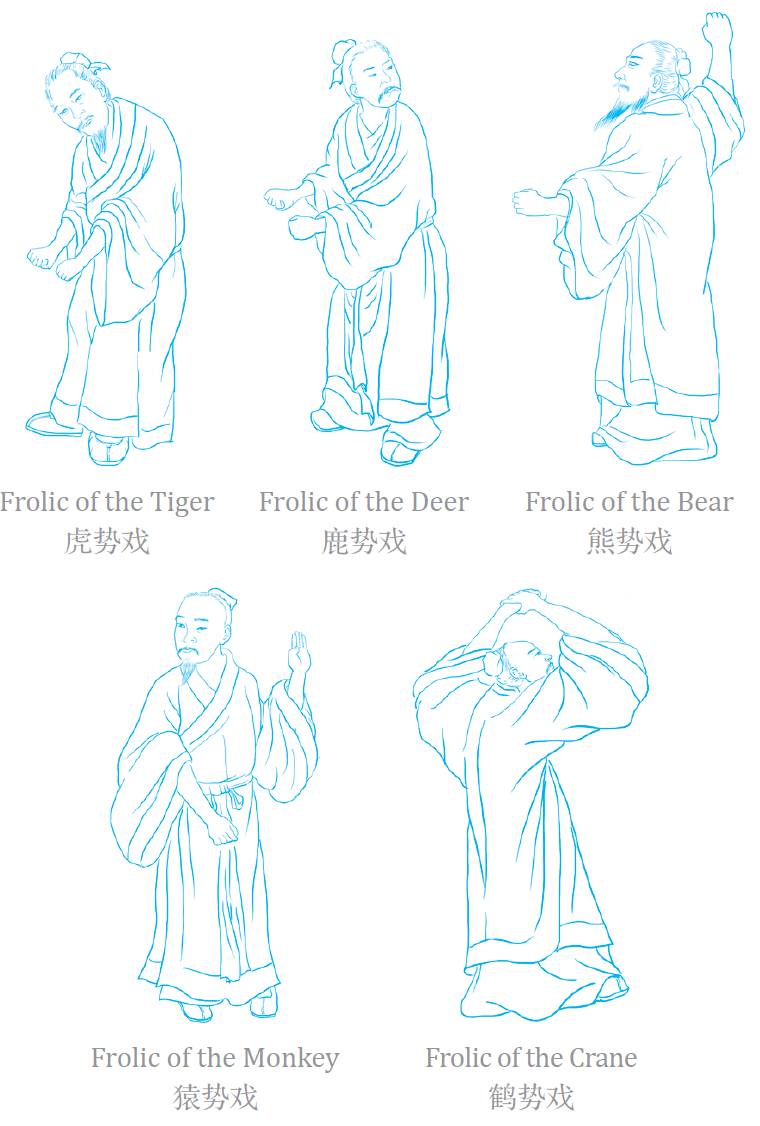
五禽戏 【wǔ qín xì】
传说是由东汉名医华佗模仿虎、鹿、熊、猿、鹤五种动物的动作创编的一套防病、治病、延年益寿的医疗气功。它是一种外动内静、动中求静、动静兼备、有刚有柔、刚柔并济、内外兼练的仿生功法。最早记载“五禽戏”名目的典籍是《后汉书》与《三国志》。
- Full-Lotus Posture
A sitting posture: To put the left foot on the right thigh and right foot on the left thigh so that both soles of the feet face upward. It is essential to hold the head, neck and spine upright and hollow the chest. Place both hands naturally on the laps.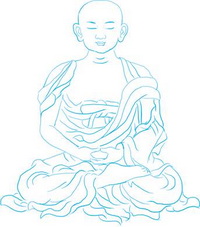
双盘坐 【shuāng pán zuò】
练功盘坐姿势的一种。两足交叉相置于大腿上,足心朝天,头正颈直,竖脊涵胸,两手自然放置腿上。
- Gold Alchemy
This term is originated in Daoism. The first word ‘gold (jin)’ means eternal and its property remains indestructible before or after being refined. The second word ‘alchemy (dan)’ means the inherent nature of Exquisite Completeness or Absolute Reality.
金丹 【jīn dān】
源于道家。金,指金性不坏;丹,指妙明圆觉之本性。
- Guidance of Thought
This means to guide the person in qigong practice to relax the entire body using his/her own or other people’s words, thoughts, voices, temperature or illusions. This includes relaxing guidance, breathing guidance and disease-treating guidance. Clinically it is more commonly used for mental illnesses.
意念诱导 【yì niàn yòu dǎo】
指借助于练功者自身或他人语言、意念、声音、温度、幻景等,诱使练功者身心放松的方法。主要有放松诱导、呼吸诱导、意念诱导、治病诱导等。临床多用于治疗心理疾病。
- Guiding Qi with Intention
This means to guide internal qi with intention to circulate along the meridians during qigong practice.
以意领气 【yǐ yì lǐng qì】
指在行功过程中,以意念引导内气循经而行。
- Half-Lotus Posture
A sitting posture: To place the sole of one foot up on the opposite thigh. Next, place the other foot beneath the other leg to complete the posture.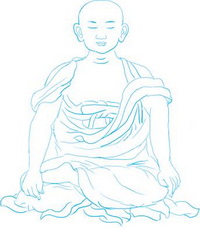
单盘坐 【dān pán zuò】
练功盘坐姿势的一种,盘膝而坐,一足置于另一侧大腿根下,另一足置于对侧大腿根上。
- Healthcare Qigong
A self-care qigong practice that applies moderate self-massage to the head, neck, torso and four limbs as well as gentle flexion, extension and rotation of the body. This practice can relax sinews, invigorate blood and benefit internal organs. Common dynamic or static methods include closing eyes to calm mind, teeth clicking, saliva swallowing, hair combing, face rubbing and covering ears to tap the occiput, etc.
保健功 【bǎo jiàn gōng】
一种自我养生保健功法。对头、颈、躯干、四肢进行的适度自我按摩和全身各部的伸屈旋转。该功法动作缓和柔韧,能达到舒筋活血、锻炼内脏的目的。常采用动、静功结合,有闭目养神、叩齿、咽津、梳头、摩面、鸣天鼓等方法。
- Health-Promotion Exercise
This is one of the folk exercise methods. It summarized the quintessence of multiple exercise methods, especially in breathing and posture such as tailor-fashion sitting and post standing. Health-promotion exercise has three major functions: nourishes qi and strengthens the body; improves health and prevents diseases; and attains longevity.
强壮功 【qiáng zhuàng gōng】
我国民间功法之一。吸收了各家功法精华综合整理而成,在呼吸和姿势方面有其特色,如盘膝坐及站桩等,有养气壮力、健身防病、延年益寿作用。
- Heart-Kidney Harmony
The heart stores the mind and is ascribed to fire, whereas the kidney stores essence and is ascribed to water. Physiologically, the two organs interact and restrain each other: kidney yang warms and nourishes heart fire; heart fire inhibits kidney water and assists kidney yang; and kidney water inhibits heart fire to prevent hyperactivity of heart fire and benefit heart yin. This relationship is also known as coordination between water and fire.
心肾相交 【xīn shèn xiāng jiāo】
心属火,藏神;肾属水,藏精。两脏互相作用,互相制约,以维持正常的生理活动。肾中真阳上升,能温养心火;心火能制肾水泛滥而助真阳;肾水又能制心火,使不致过亢而益心阴。这种关系,也称水火既济。
- Heat Sensation
One of the eight physical sensations originated in Buddhism: a sensation that the body feels as hot as fire.
暖触 【nuǎn chù】
源于佛家。八触之一,指感到身热如火。
- Heavenly Heart
Originated in Daoism, it refers to the true heart of Miao Yuan (Exquisite Completeness or Absolute Reality). According to the commentaries by Wang Chong-yang[1] in the Preface to Five Numinous Chapters (Wu Pian Ling Wen Xu), ‘What we call the heavenly heart is the true heart of Exquisite Completeness. In essence, the true heart is exquisite and luminous. It is colorless, pure and clean…it is the root of Taiji, the void of non-being, the source of yin and yang and the heart of heaven and earth, that’s why it’s called the heavenly heart.’
[1] It is a Chinese historical text which covers the history of the late Eastern Han Dynasty (184-220 CE) and the Three Kingdoms period (220-280 BCE).
天心 【tiān xīn】
源于道家。指妙圆之真心。《五篇灵文· 序》王重阳注:“天心者,妙圆之真心也。释氏所谓妙明真心,心本妙明。无染无著,清净之体……此心乃太极之根,虚无之体,阴阳之祖,天地之心,故曰天心也。”
- Heaviness Sensation
One of the eight physical sensations originated in Buddhism: a sensation that the body weighs like an immovable mountain.
重触 【zhòng chù】
源于佛家。八触之一,指感觉身重如山,不能移动分毫。
- Heel Breathing
Originated in Daoism, it refers to long, continuous and unbroken breathing that can be deep down to the heels.
踵息 【zhǒng xī】
源于道家。指绵绵不绝的深长呼吸,气息深达脚跟。
- High-position Post Standing
The high position does not need to lift down your upper body to a low position and therefore may not be energy-consuming. There are different levels of post standing: high position, middle position and lower position.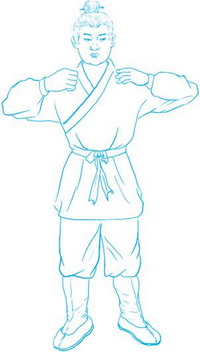
高位桩 【gāo wèizhuāng】
指架势高、消耗量低的一种站桩架势。站桩以其姿势难度可分为高位站桩、中位站桩和低位站桩三种。
- Illusions of a Connected Heavenly Circle
This refers to illusions of a fast qi connecting through the Du and Renchannels due to enhanced guidance of thoughts before the yuan-primordial qi becomes adequate enough.The Essay on the Understanding of the Truth (Wu Zhen Pian) criticized this state as ‘consuming water and fire in vain because there is no real alchemy in the tripod’. It’s believed that illusions of a connected heavenly circle may do more harm than benefit to the body.
意通 【yì tōng】
指在练周天功时,元气尚未充足之前就加强意念诱导,从而在短时间内出现气在任、督二脉运行的幻感。《悟真篇》批评这种状态为“鼎内若无真种子,犹将水火煮空铛”。意通对于人体无甚裨益,有时还有一定的弊端。
- In Meditation
This refers to a state of highly relaxed tranquil with concentration and clear consciousness during qigong practice.
入静 【rù jìng】
在练功时,排除杂念、神志清醒下所出现的高度安静、轻松舒适的一种练功状态。
- Ingestion of Qi
It is also called ‘intake of qi’ or ‘circulation of qi’. Ingestion of qi is an exercise method mainly composed of inhalation, exhalation and meditation. The Scripture on Qi Ingestion (Fu Qi Jing) and the Mnemonic Formula for Qi Ingestion (Fu Qi Kou Jue) in the Daoist Canon (Dao Zang) recorded numerous qi-ingesting methods.
服气 【fú qì】
又称食气、行气。以吐纳为主,结合存想的功法之一。《道藏》中的《服气经》《服气口诀》等典籍载有多种服气功法。
- Inherent Nature
Inherent nature is the foundation or root of mental activities, also known as the ‘nature of being human’. In the context of health cultivation, inherent nature refers to the fundamental nature behind the manifestation or expression. It is also called ‘the primordial spirit’ since it dominates the body.
性 【xìng】
指人意识活动的基础或源头,即人之本体。气功中,性指人的本来面目、一身主宰,又称为“元神”。
- Inner Landscape
It can mean ① inner images, referring to inner scenes of internal organs, sinews, meridians, qi and blood occurred during qigong practice. ② pictures of how essence, qi and spirit change within the body. ③ pictures of inner contemplation during qigong practice.
内景 【nèijǐng】
① 又称内象,指练功中出现的脏腑、筋骨、经络、气血等的内在景象。② 人体内部精、气、神变化的图景。③ 练功中存想作意的景象。
- Inner Nourishment
It is a method to cultivate one’s inherent nature, including meditation, daoyin and breathing exercise.
内养 【nèi yǎng】
指修身养性之道。包括静坐、导引、吐纳等方法。
- Insight Meditation
① In Buddhism, it’s known as Vipasana in Sanskrit and Pi Po She Na or Pi Po Zhe Na in Chinese Pinyin, referring to contemplation (insight), the way to contemplate and the right way to contemplate. This term means to look into the true nature of reality through introspection. Alternatively, it can also refer to general Buddhist practice. ② In Daoism, insight meditation refers to illuminate internal bodily scenes using the thought or wisdom light (that can pierce darkness). There are two levels of insight meditation practice. The first level is to concentrate on the body to chain up the capering monkey and galloping horse (in a restless and whimsical state), with the goal of enabling the ears not to hear, the eyes not to see, the mind not to distract and the thought not to go wild. According to the Zhong Lu Chuan Dao Ji (Doctrine Collections of Zhongli Quan and Lu Dongbin), yang ascending (refining alchemy with fire) images during insight meditation may include men, fire, heaven, cloud, crane, sun, horse, gold tripod and putting firewood into fire, etc.; yang descending images during insight mediation may include women, tiger, water, earth, rain, tortoise, moon and cow, etc.; and yin-yang (tiger and dragon) intercourse images during inner meditation may include meeting of a golden boy and a jade girl led by an immortal, full blossom of rare flowers in rain, a fairy riding on a phoenix to offer immortal juice and auspicious clouds, etc. The second level of insight meditation is to concentrate on the mind (spirit) instead of the body, with the goal of thinking of nothing at all, making no will as the will and eventually achieving the ‘unity of internal fire, spirit and Dao’. The Qing Jing Jing (Sutra of Quietness and Purity) states, ‘when they try to see objects, there is no shape to describe; when they look into the hearts, there is no thought to arise’.
内观 【nèi guān】
① 佛家内观。梵语 Vipasana,音译作毗婆舍那、毗婆遮那。即观、观法与正观。即不向外求而深自内省,使内心趋向于真理之观察,亦指佛教一般之实践修行。② 道家内观。指用意念或慧光照耀体内各种景象。有二种层次的修炼。一为观形之内观,即以“无中立象心定识神”,由此锁住心猿意马,使耳不闻,目不见,心不狂,意不乱。《钟吕传道集》称内观 “阳升之象”,内观“进火烧炼丹药之象”,如为男、为火、为天、为云、为鹤、为日、为马、为金鼎、为执薪燃火等;内观“阳降之象”,如为女、为虎、为水、为地、为雨、为龟、为月、为牛等;内观“龙虎交媾而匹配阴阳之象”;内观“采取进火之象”。所看到的景象有仙人引金童玉女相会、天雨奇花、仙娥乘彩凤祥鸾来献玉浆、祥风瑞气起于座前等。二为观神之内观,指观乎神而不观乎形,强调绝念无想,以无心为心,最终达到“内官起火,炼神合道”。《清静经》曰:“外观其形,形无其形;内观其心,心无其心。”
- Internal Alchemy
Originated in Daoism, it refers to an important Dao practice. Using the body as a tripod stove and using essence, qi and spirit as medicine, the goal of internal alchemy is to cultivate both inherent nature and life endowment to strengthen the body and attain health and longevity.
内丹术 【nèi dān shù】
源于道家。指以身体为鼎炉,以精、气、神为药物,进行性命修炼,以强身健体、提高生命质量为目的,是一种重要的道家修炼方法。
- Internal Breathing
Unlike normal breathing, this refers to the continuous, unbroken and intangible breathing during qigong practice. See ‘fetal breathing’ for reference.
内呼吸 【nèi hū xī】
与一般的呼吸不同,在练功中呼吸不绝,若有若无的呼吸状态。参考“胎息”。
- Internal Qi
Internal qi can mean ① congenital yuan-primordial qi, qi distributed in the zang-fuorgans and meridian and acquired qi from breathing, water and food; however it mainly refers to yuan-primordial qi. ② the breathing within the body activated by the yuan-primordial qi.
内气 【nèi qì】
① 即先天元气及分布在脏腑、经络之气与后天呼吸之气、水谷之气相综合之气,其中以元气为主。② 指在元气的推动下,在人体内周流运行的那部分气息。
- Internal Visualization
It is also called ‘internal or reversed contemplation’. See ‘Reversed/Internal Contemplation (fǎn guān)’.
内视 【nèishì】
又称“返观内照 ”, 同“返观 ”, 见“返 观”条。
- Involuntary Body Movements
It is a special qigong practice method, referring to a variety of involuntary body movements in a state of relaxation and tranquil.
自发动功 【zì fā dòng gōng】
气功中一种特殊的练功方法,泛指在人放松、入静,没有主观意识指令下出现的各种自发性运动。
- Inward Contemplation
Originated in Daoism, it is also called Inward Thinking (Cun Xiang in Chinese or ‘Cun’ in short), inward contemplation is a Daoism practice: to close the eyes completely or partially to visualize an object, a scene or active state in order to remove distracting thoughts and become tranquil. One can visualize meteorological phenomena (sun, moon, five stars and cloud), scenes (qi, fire flame), human body (five-zang organs, Dan Tian) and spirit (internal and external). Focusing on internal or external spirit is called ‘Spirit Contemplation’.
存思 【cún sī】
源于道家。又称存想,简称“存”,道教修炼方术之一。要求闭合双眼或微闭双眼,存想内观某一物体或神真的形貌、活动状态等,以期达到集中思想,去除杂念,进入气功境界。存思对象很广泛,包括存思天象(日、月、五星,云雾)、景物(气、炎火)、人体(五脏、丹田)及神真(身内神和身外神)等。单存身内、身外诸神者名“存神”。
- Inward Thinking
See the above ‘Inward Contemplation’.
存想 【cún xiǎng】
同“存思”,见“存思”条。
- Itching Sensation
One of the eight physical sensations originated in Buddhism: an itching sensation in the body as if there is nowhere to place oneself.
痒触 【yǎng chù】
源于佛家。八触之一,指身体上发痒,好像无置身之处。
- Jia Ji Pass
One the of the three passes, also known as the Lu Lu pass or double Jia Ji passes. Location: on the back and at the midpoint of the line connecting two olecranons in a prone position.
夹脊关 【jiá jǐ guān】
三关之一。又称辘轳关、夹脊双关。在背部,俯卧时正当两肘尖连线点正中处。
- Knee Sitting
A sitting posture in ancient China: To touch the floor with the knees, both soles facing upward and make the body upright.
跪坐式 【guì zuò shì】
中国古时的坐姿之一,两膝着地,脚掌朝上,两腿并拢,身体自然正坐于脚踝。
- Large Heavenly Circle
Originated in Daoism, it refers to the second stage of internal alchemical process, i.e., to transform qi into spirit. This is performed on the basis of the small heavenly circle exercise. Internal alchemists believe that the large heavenly circle can connect spirit with qi, improve health and attain longevity.
大周天 【dà zhōu tiān】
源于道家。大周天是道家内丹术功法中的第二阶段,即炼气化神。它是在小周天的基础上进行的修炼。内丹术认为,大周天能使神和气密切结合,相抱不离,可达到延年益寿的目的。
- Life Endowment
This refers to essence and qi of the human body.
命 【mìng】
泛指人体之精与气。
- Listening to One’s Breathing
Also known as listening to one’s qi, this term refers to focusing on one’s own breathing or qi during qigong practice. It is quoted from the Tai Yi Jin Hua Zong Zhi (The Secret of Golden Flowers), ‘Be attentive to the sound of your breathing; however, do not make your breathing audible; listening means listening to the silence’.
听息 【tīng xī】
又称听气。指练功时,用心关注于呼吸,即注心于息。《太乙金华宗旨》谓:“存心于听息,息之出入不可使耳闻,听唯听其无声。”
- Lower Dan Tian
This term is originated in Daoism. Originally, the Dan Tianrefers to ‘elixir field’ in an internal alchemical process. Today, it generally refers to the site where the mind is centered during qigong practice. The lower Dan Tian is located in the lower abdomen below the navel.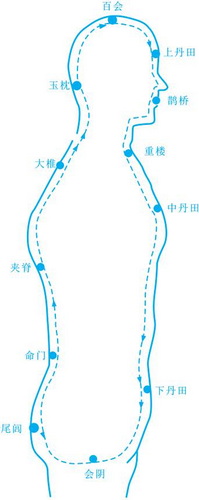
下丹田 【xià dāntián】
源于道家。丹田原指道家修炼中炼丹、结丹之处,现指练功时意守之处。下丹田,一般指脐下小腹的部位。
- Low-position Post Standing
The lower position needs to lift down your upper body to the very low position and can be energy-consuming. There are different levels of post standing: high position, middle position and lower position.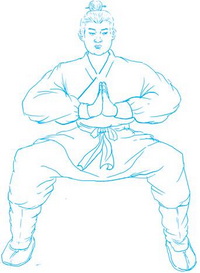
低位桩 【dī wèi zhuāng】
指架势低,消耗量较大的一种站桩姿势。站桩以其姿势难度来分,可分为高位站桩、中位站桩和低位站桩三种。
- Lying-down Qigong Practice
One of the qigong practice methods in lying postures.
卧功 【wò gōng】
气功功法的一类。泛指采用躺卧姿势的气功功法。
- Magpie Bridge
This term is originated in Daoism. There is an upper magpie bridge and a lower magpie bridge. The upper magpie bridge is located at glabella (Yintang) (solid) and nasal cavity (vacant); the lower magpie bridge is located at the coccygeal end (solid) and anus (vacant). When passing these two bridges during qigong practice along the small heavenly circle, it is important to avoid leak of essential qi.
鹊桥 【què qiáo】
源于道家。分为上鹊桥和下鹊桥,上鹊桥在印堂、鼻窍处,一虚一实;下鹊桥在尾闾、谷道处,亦一虚一实。内丹小周天功,精气在任督脉上运转,当精气通过这两个衔接地方时,要防其走漏,致精气外泄。
- Medicinal Substances
Originated in Daoism, it refers to vital essence (jing), qi and spirit (shen) in internal alchemical process and minerals like cinnabar in external alchemical process.
药物 【yào wù】
源于道家。内丹术中指人体精、气、神;外丹术中指朱砂等矿物。
- Meditative Contemplation
This term is originated in Buddhism. In Chinese, the first word ‘Chan’ means inner peace and tranquility through mental concentration; the second word ‘Guan’ means the objects to think about in a meditative state. When used in combination, this term refers to contemplate truth in seated meditation.
禅观 【chán guān】
源于佛家。禅,指集中意识后获得的心性统一和安定。观,观想。指处于禅的境地中保持详尽的观照,即坐禅而观照真理。
- Mental Aberrations
Originated in Buddhism, mental aberrations refer to distractions related to greed, anger and ignorance. There are six types of mental aberrations, namely ① the five senses themselves not functioning properly. ② external distraction or inability to concentrate the attention. ③ internal distraction or mental confusion. ④ appearance deception, lack of conviction or trust in doing good things despite showing so in appearance. ⑤ distraction caused by ideas of mean and mine, personality, possession, etc. ⑥ confusion of thought produced by Hīnayāna ideas.
散乱 【sàn luàn】
源于佛家。指因为贪、瞋、痴而分心流散的精神状态。可分为六种,即① 自性散乱。②外散乱。③ 内散乱。④ 相散乱。⑤ 粗重散乱。⑥ 作意散乱。
- Mental Attachment
Originated in Buddhism, it refers to erroneous attachments or illusions. There are two common illusions, ① Ego attachment (Wo Zhi): To cling to the reality of the ego, permanent personality, the soul or self. ② Dharma attachment (Fa Zhi): To cling to the reality of dharma, things or phenomena. Both illusions arise from holding to the reality of the ego and of things (resistant to adaptions). Later, this word is also used to describe someone who is stubborn and will not Listen to orther people’s advice or change their way of doing things.
执着 【zhí zhuó】
源于佛家。指片面而孤立地理解并固执事物的妄情和妄想。众生虚妄的“执着”,主要是“我执”和“法执”。① 我执,指固执常一不变的主宰之“我”,从而产生种种“我见”。② 法执,指固执境界实有,从而产生虚妄分别的“法见”。后亦以“执着”谓固执而不知变通。
- Meridians or Channels
Meridians are pathways for circulation of qi and blood. Meridians can be regular or extraordinary. There are twelve regular meridians — three yin meridians of both hands and feet and three yang meridians of both hands and feet. The twelve regular meridians are the main pathway for circulation of qi and blood. There are eight extraordinary meridians — Du, Ren, Chong, Dai, Yinqiao, Yangqiao, Yinwei and Yangwei meridians. The eight extraordinary meridians govern, connect and regulate the twelve regular meridians. Besides, there are twelve divergent meridians to facilitate the interior-exterior connection of the twelve regular meridians. The divergent meridians can supplement for the regular meridians because they can reach tissues or body parts that regular meridians cannot.
经脉 【jīng mài】
指人体内气血运行的通路。经脉可分为正经和奇经两类。正经有十二,即手足三阴经和手足三阳经,合称“十二经脉”,是气血运行的主要通道。奇经有八条,即督、任、冲、带、阴蹻、阳蹻、阴维、阳维,合称“奇经八脉”,有统率、联络和调节十二经脉的作用。“十二经别”,是从十二经脉别出的经脉,主要是加强十二经脉中相为表里的两经之间的联系,还由于它通达某些正经未循行到的器官与形体部位,因而能补正经之不足。
- Middle Dan Tian
Originated in Daoism, also known as the Middle Palace (Zhong Gong) or Purple-red Palace (Jiang Gong), it refers to an important body part in the pectoral region. It was first recorded in the inner chapter of Terrestrial Truth, Book of the Master Who Embraces Simplicity (Bao Pu Zi[1] Di Zhen Pian), ‘Jiang Gong (another name Jin Que) below the heart is the middle Dan Tian’. Except few people believe the middle Dan Tian is located below the navel, most people think the middle Dan Tian is located at Danzhong (RN 17, midpoint of the line connecting the two nipples), a place to store qi.
[1] Bao Pu Zi is a pen name of Ge Hong, a Jin dynasty scholar best known for his interest in Daoism, alchemy, and techniques of longevity.
中丹田 【zhōng dān tián】
源于道家。别名中宫、绛宫等。人身胸部的重要部位,最初见于《抱朴子· 地真篇》:“心下绛宫、金阙,中丹田也。”除少数认为中丹田在脐下外,大多数都认为中丹田在两乳之间的膻中穴,其为藏气之处。
- Middle-position Post Standing
The middle position consumes moderate energy compared with a high or low position. There are different levels of post standing: high position, middle position and lower position.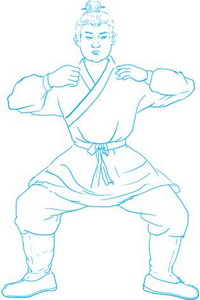
中位桩 【zhōng wèizhuāng】
指介于高、低位之间,消耗量适中的一种站桩架势。站桩以其姿势难度来分,可分为高位站桩、中位站桩和低位站桩三种。
- Mild (Civil) Fire
Originated in Daoism, also known as a symbol for mental tranquility, it refers to mild and slow fire, i.e., gentle persistent breathing. The Complete Guide to Tao Practice (Xiu Dao Quan Zhi) states, ‘A mild fire means to guide and lead with soft breathing’. Generally, it involves long intentional exhalations and short natural inhalations in order to allow internal qi to slow down in descending.
文火 【wén huǒ】
源于道家。又称退阴符。喻指火力小而缓。在传统内丹术中则指持续地轻缓呼吸,《修道全指》:“文火者,即呼吸之气,微轻导引。”一般是呼气时着意而长,吸气时自然而短。其目的是使内气缓行降沉。
- Mind Concentration
In Chinese, the first word ‘yi’ means intent, thought or mind. The second word ‘shou’ means to concentrate and maintain. This term refers to the method and process of concentrating and maintaining the mind on a certain object or a specific body part. The mind concentration can help to remove distracting thought, replace the ten thousand thoughts with one single thought and gradually become meditative.
意守 【yì shǒu】
意,指意识、意念或精神。守,指集中和持守。意守通常是指气功锻炼过程中,将意念集中和保持在身体某一部位或某一事物上的方法和过程。通过意守,可以帮助排除杂念,实现“一念代万念”,逐步达到气功入静状态。
- Mind-Breath Interdependence
In Chinese, the first word ‘xin’ means true intention. The second word ‘xi’ means breathing. By regulating breathing with mind and controlling control mind with breathing, one can enter a perfect harmony between inherent nature and life endowment. This term refers to a deep meditative state of mind-breath interdependence.
心息相依 【xīn xī xiāng yī】
心,指真意;息,指呼吸。指心与息合一的深度入静状态。以心调息,以息摄心,心息相依交抱,性命自能相融。
- Mind-Regulation
This means to regulate the mind or inherent nature, referring to cultivation of mental intent, cleanse the mind and remove distracting thoughts.
调心 【tiáo xīn】
指气功锻炼中,调整心性意识,修心涤虑,排除妄念,即对意识、心性的锻炼。
- Mud Pill
Originated in Daoism, it can mean ① Location: Ancient people believed that brain houses the mind, they used Ni Wan (a Chinese rendering of the Buddhist Sanskrit ‘Nirvana’) to represent the brain. ② primordial spirit, also known as the upper Dan Tian.
泥丸 【ní wán】
源于道家。① 指位置。古人以脑中有泥丸之地为神之所舍,故曰泥丸。② 指脑中元神。一般认为即上丹田。
- Mysterious Pass
Originated in Daoism, it refers to an important aperture in the body. Since this aperture is formless and has no fixed location, one cannot feel its existence until in high levels of qigong practice.
玄关 【xuán guān】
源于道家。指人体一处重要的窍穴,该穴无形无相、无方无所,只有在练功至一定程度时才能体会到。
- Natural State of Relaxation and Tranquil
This is a basic requirement for qigong practice. In Chinese, the first word ‘song’ refers to relaxation of the body and mind; the second word ‘jing’ refers to mental tranquil; and the last two words ‘zi ran’ refer to a harmonious state between body and mind.
松静自然 【sōng jìng zì rán】
松,指身心的放松;静,指心意的宁静。身心相融,和谐自然,是气功锻炼中的基本要求。
- Nature/Character Cultivation
Originated in Daoism, it mainly focuses on cultivating one’s nature, i.e., cultivating the primal spirit from the upper Dan Tian.
性功 【xìng gōng】
源于道家。指修性为主的内丹功法。即从上丹田元神处入手修炼的功法。
- Normal Abdominal Breathing
This refers to abdominal bulging during inhalation and abdominal retraction during exhalation.
顺腹式呼吸 【shùn fù shì hū xī】
指吸气时腹部隆起,呼气时腹部回复的腹式呼吸方法。
- Nose Breathing Regulation
One of the breath regulating methods during qigong practice. It refers to regulate breathing by focusing the eyes on the tip of the nose with the goal of achieving even, gentle and continuous breathing.
调鼻息 【tiáo bí xī】
调息的一种,指观鼻尖调整呼吸,以达到调柔细匀,呼吸绵绵的一种状态。
- Nourishing Life
This means to preserve and nourish life through a variety of methods to promote health, strengthen the body, prevent diseases and thus attain longevity.
养生 【yǎng shēng】
以颐养生命、增强体质、预防疾病、延年益寿为目的的多种保健方法的综合。
- One-Finger Meditation Exercise
① The method of one-finger meditation in Buddhism: Sit upright with legs crossed, close both eyes so that only a fine light can enter in, but yet enough so that the tip of the nose can still be gazed upon. Place the index finger in front of the chest, and gaze at the finger with mental consciousness in order to experience from quietness to tranquil, then to meditation and finally to awareness. ② one-finger vajra (diamond and thunderbolt) pestle in martial arts texts, referring to inner strength of one finger. It is often used in attacking vital pressure points for conquering an enemy or treating ailments.
一指禅功 【yī zhǐchán gōng】
① 指佛家一指修禅功,其法为趺坐垂目,举手伸食指立于胸前,双目含光凝视食指,意守不移,由静而定,由定而禅,由禅而悟。②指武功一指金刚杵,修炼之法以专修一指之力为功。一指禅一般用于点穴,以制敌及治病。
- Panting
Originated in Buddhism, it means that when seated, there are no breathing sounds but one can sense obstruction or hindrance in breathing.
喘相 【chuǎn xiàng】
源于佛家。打坐时气息虽无声,而入出结滞不通。
- Post Standing
In Chinese, the first word ‘zhan’ means to stand and the second word ‘zhuang’ means an immobilized ‘timber pile’ driven into the ground. Literally, ‘zhan zhuang’ can be translated as ‘standing like a post’, ‘standing like a tree’, ‘standing-on-stake’, ‘post standing’ or ‘pile standing’. This practice aims to maintain a fixed posture of the torso and four limbs to cause persistent tension of static force, thus attaining mental focus, relieving ailments and strengthening the body.
站桩 【zhàn zhuāng】
“桩”有树木深根在地,固定不动之意,喻身体如木桩站立不动。站桩功是以站式为主,使躯干、四肢保持一定的姿势而让某些部位呈持续的静力性紧张,从而使意念集中、祛病强身的练功方法。
- Practice Mindfulness
Originated in Buddhism, it refers to a state of mind steadily fixed on one place, or in one position.
修止 【xiū zhǐ】
源于佛家。指练功时意识宁静,安止于一处。
- Qi
Qi is an essential substance to nurture the body. It can reflect the functional activities of internal organs. It is also believed to be the most basic substance constituting the body and the world.
气 【qì】
指充养人体的一种精微物质,也指人体脏器的功能活动。气被认为是构成人体和世界的基本物质。
- Qi Circulating along the Heavenly Circle
Originated in Daoism, it includes small circle (also called midnight-noon heavenly circle, tamping the base within a hundred days, or ‘combining Kan, i.e., kidney yin with Li, i.e., heart yang) and large heavenly circle (also called sunrise-sunset heavenly circle or coordination of yin and yang).
周天功 【zhōu tiān gōng】
源于道家。周天功包括小周天功(又名子午周天、百日筑基、取坎填离等)和大周天功(又名卯酉周天、乾坤交媾等)。
- Qi Point
This refers to the lower Dan Tian, i.e., the region to generate and store essential qi.
气穴 【qì xué】
指下丹田。下丹田被认为是生发和关藏精气的部位。
- Qigong Deviation
This refers to a physiological or psychological disorder resulting from improper practice of qigong. It often manifests as undesirable somatic or psychological effects. Qigong deviation can be classified into two categories: Zou Huo (literally means walking into fire): associated with qi disorder and mainly manifests as somatic symptoms; and Ru Mo (literally means entering demon): associated with psychological disorder and mainly manifests as mental symptoms.
练功偏差 【liàn gōng piān chà】
指练功所引发的以一系列身心异常感觉为主要表现的身心综合征。主要分两类:一类由气机紊乱引起,以躯体症状为主,俗称“走火”;一类由精神障碍引起,以精神症状为主,俗称“入魔”。
- Qigong Reactions
These refer to normal or abnormal physiological or psychological reactions during qigong practice. For beginners, normal reactions may include improvement in appetite, bowel movements, sleep and spirit. Some may experience the ‘eight physical sensations’. Abnormal body-mind reactions include headache, distension of the head, chest tightness, chest pain, distension and pain in the hypochondriac region, low back soreness, back pain, heat or cold sensations in the Dan Tian(or body). Some may even experience mild palpitations and increased bowel or bladder movements.
练功反应 【liàn gōng fǎn yìng】
指气功锻炼过程中出现的与练功有关的人体生理、心理反应。它可以分为正常反应与异常反应两大类。正常反应包括初练者有食欲、排便、睡眠、精神等方面的改善,深入者有 “八触”等;异常反应包括练功不当产生的身心不适甚至偏差,如:头痛头胀、胸闷胸痛、胁肋胀痛、腰酸背痛、腹部酸痛、丹田(或身体)过热(或冷),有时还可有心悸、便多等,一般 都不严重。
- Qi-Holding
Same as breath-holding.
闭气 【bì qì】
又称“闭息”,见“闭息”条。
- Recycled Elixir
Originated in Daoism, it means to return to the inherent and primal nature. The term ‘recycled elixir’ were originated from the Kinship of the Three, in Accordance with the Book of Changes (Zhou Yi Can Tong Qi)[1], ‘Only when the flow of qi follows its inherent nature, can the elixir be recycled’.
[1] The text was composed by Wei Bo-yang in the mid-second century CE, and deals entirely with alchemy — in particular, with internal alchemy (Nei Dan).
还丹 【huán dān】
源于道家。喻指返本归元。“还丹”一词出《周易参同契》:“金来归性初,乃得称还丹。”
- Recycled Elixir of Jade Fluid
Originated in Daoism, it refers to swallowing the saliva down to the lower Dan Tian during the internal alchemical process.
玉液还丹 【yù yè huán dān】
源于道家。指将内丹修炼过程中口内产生的津液咽入丹田。
- Recycling Essence to Tonify the Brain
Originated in Daoism, it refers to nourish the brain (sea of marrow) with recycled essence and blood through internal alchemic process. This can further reinforce the ability of thinking and sharpen the sensation. Both ‘refining essence to transform into qi’ in exercise of the small heavenly circle and the ‘refining qi to transform into essence’ in exercise of the large heavenly circle can supplement brain with recycled essence.
还精补脑 【huán jīng bǔ nǎo】
源于道家。练功至体内精血充盈,元精充满,髓海(脑)得到濡养,遂使思维能力加强,感觉敏锐的一步功夫。在内丹术中,从小周天功的 “炼精化气”到大周天功的“炼气化神”,皆属还精补脑的功夫。
- Red Dragon
Originated in Daoism, it can mean ① essential qi. ② tongue. ③ menstruation.
赤龙 【chì lóng】
源于道家。① 指精气。② 指舌头。③ 指妇女的月经。
- Refining Qi to Transform into Spirit
Originated in Daoism, it refers to transform qi into spirit. Lin Pei-qin from the Qing dynasty mentioned in the Categorized Patterns with Clear-cut Treatments (Lei Zheng Zhi Cai), ‘Spirit is generated by qi and qi is transformed from essence; essence can be transformed into qi and qi can be transformed into spirit. Consequently, essence is the root of the body, qi is the treasure of the body and spirit is the house of the body’. It is generally considered as the second stage of internal alchemy.
炼气化神 【liàn qì huà shén】
源于道家。精化为气后,更可转化为神。清· 林珮琴《类证治裁》:“神生于气,气化于精;精化气,气化神。故精者身之本,气者神之宝,形者神之宅。”在传统内丹术中,把炼气化神的锻炼过程作为功法的第二阶段。
- Refining Essence to Transform into Qi
Originated in Daoism, it refers to preserve essence or transform essence into qi. It is generally considered as the initial stage of internal alchemy.
炼精化气 【liàn jīng huà qì】
源于道家。在传统内丹术中指不漏精或精化气,是人体气质转化的一个重要阶段。一般把炼精化气作为内丹功法的第一阶段。
- Refining the Mind
Originated in Daoism, also known as ‘refining the self’, ‘refining the inherent nature’ or ‘cultivating the mind’, it means to remove distracting thoughts and cultivate mental concentration to begin with qigong practice. Zhang San-feng[1] states in his Treatise on Profound Principles (Xuan Yao Pian), ‘Refine the inherent nature first before recycling the alchemy, cultivate your mind first before cultivating your essence, qi and spirit (to transform into ‘medicine’)’.
[1] The text was composed by Wei Bo-yang in the mid-second century CE, and deals entirely with alchemy — in particular, with internal alchemy (Nei Dan).
炼心 【liàn xīn】
源于道家。又称炼己、炼性、修心。指练功的第一步,要求排除杂念,集中练功意念。张三丰《玄要篇》:“未炼还丹先炼性,未修大药且修心。”
- Refining the Mind
Originated in Daoism, it’s an exercise to regulate self-consciousness. See ‘refining the self’ for reference.
炼意 【liàn yì】
源于道家。调整自我意识的一种锻炼。参考“炼己”。
- Refining the Self
This term is originated in Daoism. The ‘self’ is ascribed to earth in five-element theory, meaning inner spirituality, mental activity and consciousness. It is essential for the internal alchemical process to cleanse the mind, remove distracting thoughts and put out of one’s mind while facing the scene.
炼己 【liàn jǐ】
源于道家。所谓“己”,在五行属土,指心性、思虑、意识。内丹修炼,先须修心涤虑,对境忘心。
- Regulating Four Categories of Respiration
Originated in Buddhism, it refers to four phases of breathing: unhurried breathing through the nose (feng), panting (chuan), deep and quiet breathing (qi) and stillness or rest (xi). The first three types of breathing are not well regulated, while the fourth is well regulated.
调息四相 【tiáo xī sì xiàng】
源于佛家。四相,指一者风、二者喘、三者气、四者息。前三者为不调相,后一者为调相。
- Regulating the Breath
In ancient times, breath regulation was known as inhalation and exhalation (Tu Na), qi refining (Lian Qi), qi regulating (Tiao Qi) and ingestion of qi (Shi Qi). Traditional breath regulating methods include natural breathing, abdominal breathing, anus-clenching breathing, body breathing and fetal breathing. The most common one is normal abdominal breathing.
调息 【tiáo xī】
指对呼吸的调整,又称吐纳、炼气、调气、食气等。传统的气功调息包含自然呼吸、腹式呼吸、提肛呼吸、体呼吸、胎息等。其中最常用的是顺腹式呼吸。
- Relaxation and Tranquil Practice
A static qigong practice derived from relaxation training. It pays equal attention to relaxation and tranquil. This is an easy convenient exercise for beginners. It can also be used to be ‘in meditation’ during other types of qigong practice.
松静功 【sōng jìng gōng】
指从放松功衍化出来的一类以松静为主的静功功法。具有既注意松、又注意静,松静紧密相联、相辅相成的特点。松静功方法简易、方便,它既是一种初步入门方法,也可作为练其他功法时的一种“入静”手段。
- Relaxation Training
An introductory static qigong for beginners in lying, sitting or standing postures. By pronouncing ‘song (relax)’ silently to relax all body parts in sequence and rhythm, this training can help to make the body and mind relaxed and comfortable.
放松功 【fàng sōng gōng】
指采用卧、坐、站等姿势来练习的一种入门静功。它通过有步骤、有节奏地放松身体各部位,结合默念“松”字诀,把身心调整到轻松、舒适、自然的状态。
- Restless and Whimsical State
The first two words ‘xin yuan’ mean a heart like a capering monkey. The latter two words ‘yi ma’ means a mind like a galloping horse. This term refers to distracting thoughts that occur one after another in qigong practice.
心猿意马 【xīn yuán yì mǎ】
心猿,指人心散动如猿猴不肯停伏;意马,指人的意念驱驰于外境,犹如奔马不住于一处。比喻气功锻炼中此起彼伏的杂乱意念。
- Restless Sensation
One of the eight physical sensations originated in Buddhism: a sudden vibration of the body during meditation.
动触 【dōng chù】
源于佛家。八触之一,指坐禅的时候,身体忽然生起颤动的现象。
- Reverse Abdominal Breathing
A type of abdominal breathing: the abdomen contracts inward during inhalation and relaxes outward during exhalation, causing abdominal retraction during inhalation and abdominal bulging during exhalation. It’s generally believed this breathing method can benefit gastrointestinal (GI) motility.
逆腹式呼吸 【nì fù shì hū xī】
腹式呼吸的一种。吸气时逐渐收缩而腹部凹下,呼气时自然放松而腹部逐渐隆起。一般认为逆腹式呼吸更能加强肠胃的活动功能。
- Reversed Contemplation
Originated in Daoism, it means to reverse outward mental thoughts into inward, i.e., internal contemplation. Li Shi-zhen mentions in the Consideration of the Eight Extraordinary Meridians (Qi Jing Ba Mei Kao), ‘The internal tunnel can only be illuminated by those who have reversed contemplation’. The ‘reversed contemplation’ here means to see the pathway of meridians in a reversed order. It’s similar to the term ‘internal contemplation’.
返观 【fǎn guān】
为道家术语,把向外的各种意念活动,转而向内,关注于自身内在的身心变化。李时珍《奇经八脉考》:“内景隧道,唯返观者能照察之。”与 “内观”之意相近,可互参。
- Right Awareness
Originated in Buddhism, it refers to ① true enlightenment or arising of wisdom. ② the wisdom or omniscience of Buddha.
正觉 【zhèng jué】
源于佛家。① 真正的觉悟。② 成佛也称正觉。
- Right Mindfulness
Originated in Buddhism, it refers to correct thoughts and putting aside greed and distress with reference to the world. It is one of the eightfold noble path.
正念 【zhèng niàn】
源于佛家。指正确的念头,忆念正道,不生邪念。八正道之一。
- Right Qi
Right qi is achieved through regulating one’s thinking mindset including self-reflection. It can mean ① The upright and honest qi attained through introspection and mental regulation. The Far-off Journey in the Verses of Chu (Chu Ci Yuan You) states, ‘The only way to seek right qi is to conduct introspection and uplift ethics’. ② The yuan-primordial qi of the body, as opposed to evil (pathogenic) qi. It can also be understood as the defending ability of the body, as explained in the Discourse on Needle Technique in Basic Questions (Su Wen Ci Fa Lun), ‘If there are sufficient right qi within, there is no way that pathogenic qi can invade the body’. ③ normal natural climate, also known as right wind, as quoted in the Discourse on Needling Techniques and Genuine Qi in the Miraculous Pivot (Ling Shu Ci Jie Zhen Xie Pian), ‘Right qi means the right wind’. ④ Same as ‘genuine (true) qi’.
正气 【zhèng qì】
① 指通过自我反省等调整意识思维活动的方式而得的正直之气。《远游》:“内惟省以端操兮,求正气之所由。”② 指身体的元气,针对邪气而言,亦可释为身体对外的防御能力。《素问· 刺法论》:“正气存内,邪不可干。”③ 指正常气候,又名正风。《灵枢· 刺节真邪》:“正气者,正风也。”④ 同“真气”。
- Roughness sensation
One of the eight physical sensations originated in Buddhism: a sensation that the body feels as rough as tree bark.
涩触 【sè chù】
源于佛家。八触之一,指感到身如木皮。
- Science of Qigong
A discipline about the principles and practice of self-conducted body-mind exercise methods.
气功学 【qì gōng xué】
以人体自我身心锻炼的理论与方法为研究对象的学科。
- Seated Meditation
Originated in Buddhism, it’s one of the Buddhism qigong practice methods — to sit upright, close one’s eyes and concentrate to experience true peace and tranquility.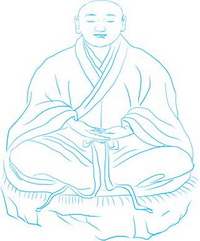
坐禅 【zuò chán】
源于佛家。佛教气功的练功方式之一,指正坐而修禅,通常是闭目端坐,凝志静修。
- Sinew Transformation Classic
In Chinese, the first word ‘yi’ means to adapt, change or transform; the second word ‘jin’ means sinews or fascia; and the third word ‘jing’ means classic. The sinew transformation contains a relatively intense form of exercise that aims at stretching the sinews or tendons to promote flexibility and strengthen the body. Wei Tuo Presenting the Pestle; Shoulder up an Evil-Banishing Pole; Support the Sky with the Palms; Plucking a Star and Exchanging a Star Cluster; Nine Ghosts Drawing Swords; Hungry Tiger Springing Its Prey; Pulling Nine Cows by Their Tails; Three Plates Falling on the Floor; Bowing Down in Salutation; Displaying Paw-Style Palms Like a White Crane Spreading Its Wings; Black Dragon Displaying Its Claws; Swinging the Tail.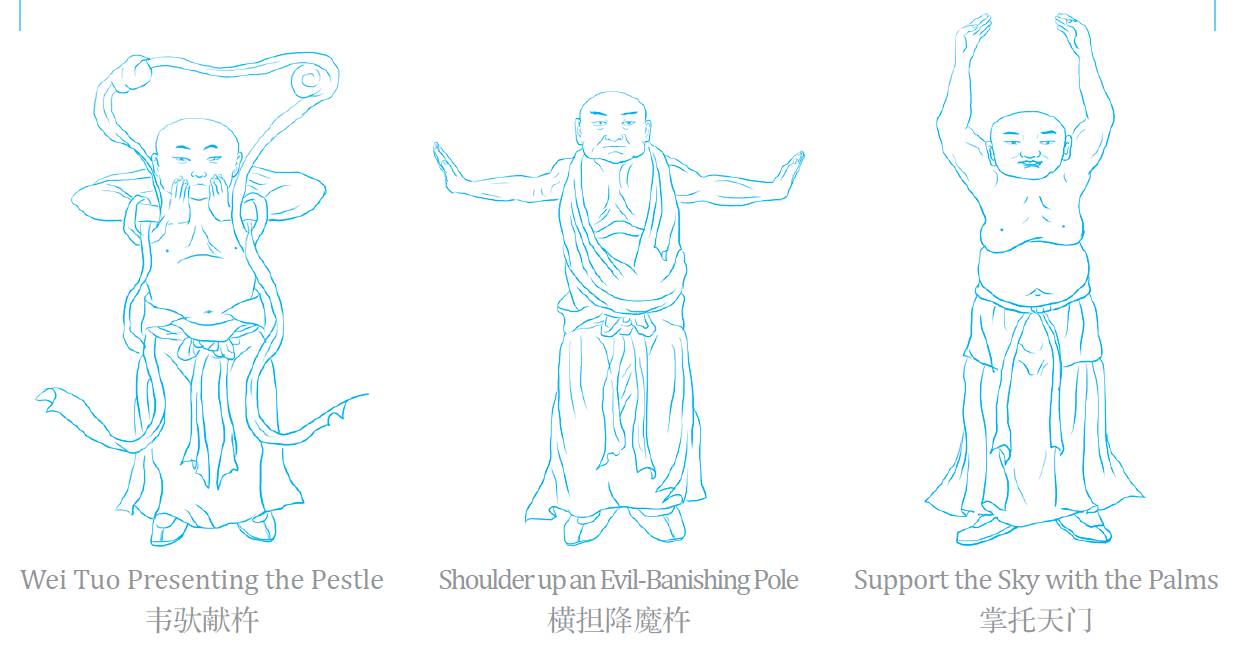
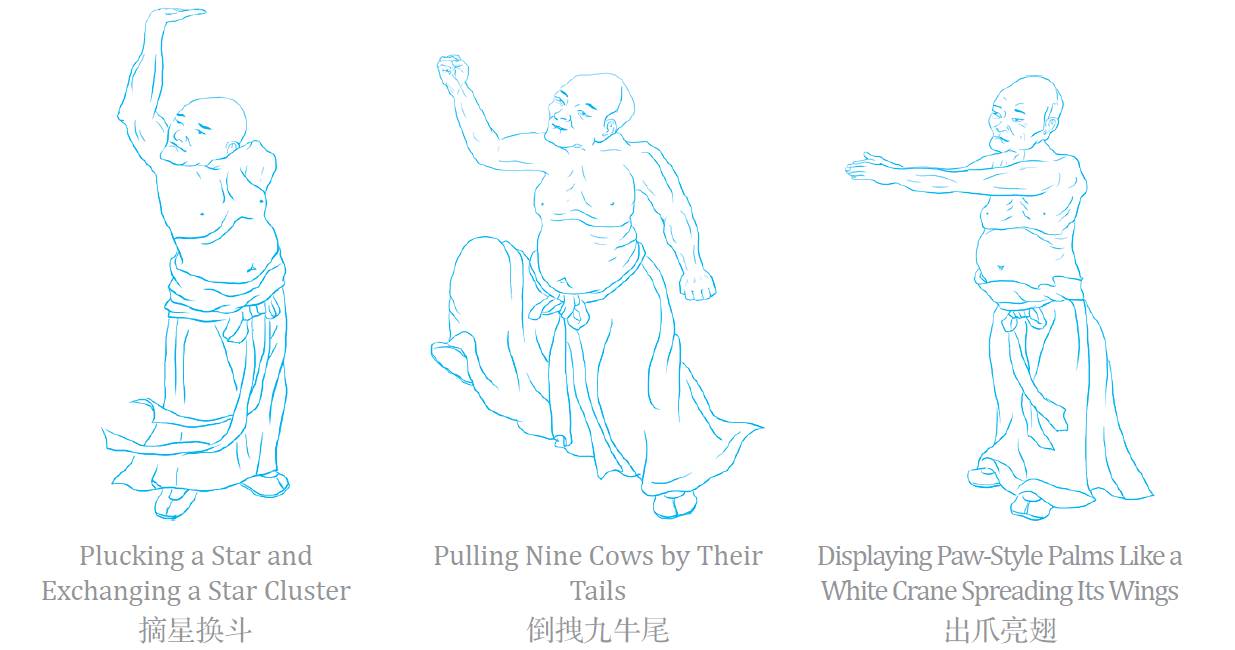
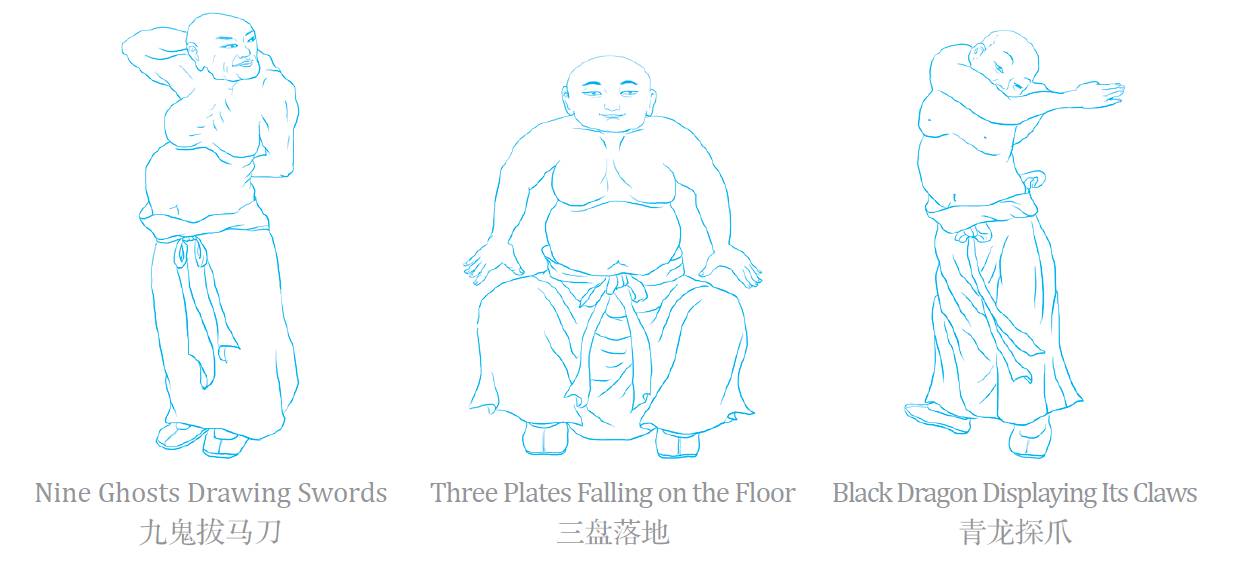
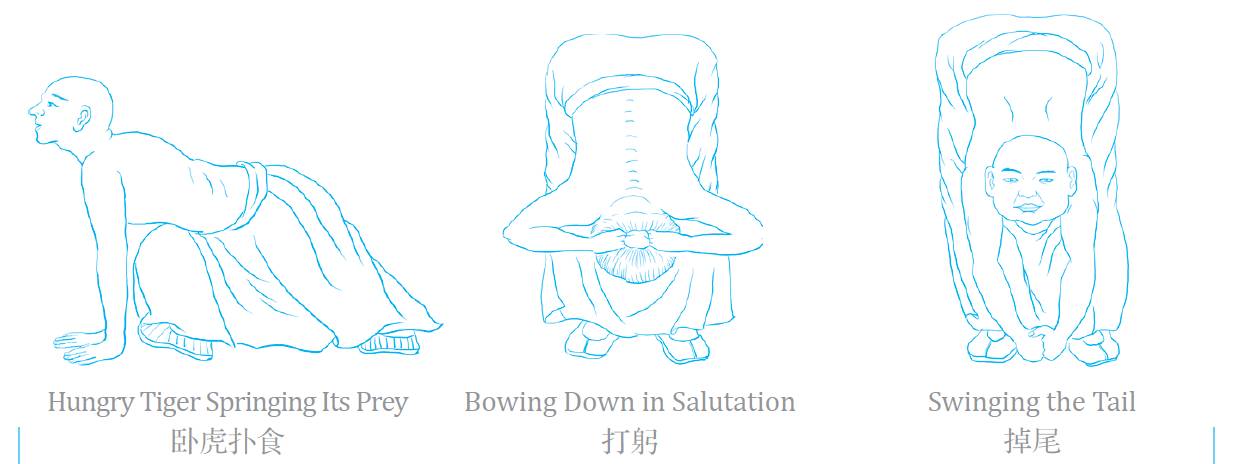
易筋经 【yì jīn jīng】
易,指变通、改换、脱换;筋,指筋骨、筋膜;经,指经典。易筋经就是变易筋骨以强身健体的一种功法。韦驮献杵;横担降魔杵;掌托天门;摘星换斗;九鬼拔马刀;倒拽九牛尾;三盘落地;出爪亮翅;青龙探爪;卧虎扑食;打躬;掉尾。
- Sitting & Forgetting
It is a state of deep or intense absorption, during which no trace of ego-identity is felt and only the underlying cosmic current of the Dao is perceived as real. The Daoist Zhuang Zi had the earliest recorded reference to sitting & forgetting in the Inner Chapter 9 — Great Masters (Da Zong Shi), ‘I slough off my limbs and trunk, dim my intelligence, depart from my form, leave knowledge behind, and become identical with the Dao. This is what I mean by ‘sit and forget’.
坐忘 【zuò wàng】
指修炼时高度入静,达到忘记自己肢体乃至于世间万物的状态,与道合一。《庄子· 大宗师》:“堕肢体,黜聪明,离形去智,同于大通(道),此谓坐忘。”
- Sitting Practice
A qigong practice method in a sitting posture.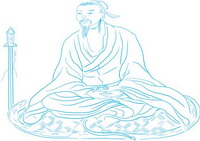
坐功 【zuò gōng】
指以坐式的姿势进行练功的方法。
- Six Healing Sounds
A breathing exercise method: pronouncing the sounds of Xu, He, Hu, Si, Chui and Xi to subtly vibrate the internal zang-fu organs and stimulate the circulation of qi and blood in meridians.
六字诀 【liù zì jué】
一种吐纳类功法。通过呬、呵、呼、嘘、吹、嘻六个字的不同发音口型,唇齿喉舌的用力不同,以调节脏腑经络气血运行。
- Six Profound Dharma Gates
Originated in Buddhism, it refers ① the name of a book written by Tiantai Master Sramana Zhiyi in Sui dynasty (589—618). ② to six methods and steps in breathing exercise, namely, counting, following, resting, visualizing, returning, and clarifying.
六妙法门 【liù miào fǎ mén】
源于佛家。指①书名,隋代智顗著。②佛教天台宗修证菩提道果的简要法门,包括一数、二随、三止、四观、五还、六净六法。
- Sleep Practice
This refers to an advanced internal alchemic practice: To flex the head and body to allow the entire body to be relaxed but not slack, allow the brain to be quiet but not asleep, and thus reach a breath-holding state of fetal breathing. This practice can regulate both body and mind, cultivate spirit and qi, and thus return to true emptiness.
睡功 【shuì gōng】
指内丹的高级修炼功法。修炼时头身卷曲,全身松而不弛,大脑静而不眠,进入抱元守一,闭气胎息的状态,从而调节身心,修养神气,达到神游紫府,还虚还无的目的。
- Small Heavenly Circle
It originally refers to the diurnal cycle of rotation of the solid Earth around its own axis. In contexts of Daoism, it refers to guide internal qi to circulate through the Du and Ren meridians.
小周天 【xiǎo zhou tiān】
原指地球自转一周,即昼夜循环一周。道家周天功将其引申为内气在体内沿任督二脉循环一周。
- Smoothness Sensation
One of the eight physical sensations originated in Buddhism: a sensation that the body feels as smooth as butter.
滑触 【huá chù】
源于佛家。八触之一,指感到身滑如脂。
- Spirit
① An umbrella term for all life activities, manifesting mental activity and essential qi of the internal organs. The Secret of Prolonging Life (Shou Shi Chuan Zhen) states, ‘The spirit dominates the entire body’. ② Changes. The Scriptures of the Great Peace (Tai Ping Jing) states, ‘Without specific forms, sprit is the result of infinite changes’. ③ A synonym of ‘heaven’. The Scriptures of the Great Peace also states,‘Spirit shares the same form with heaven, the heaven is therefore called spirit’.
神 【shén】
① 指生命活动现象的总称,包括思想活动和脏腑精气活动。《寿世传真》:“神者,主宰一身者 也。”② 指变化。《太平经》:“夫神,乃无形象变 化,无穷极之物也。”《内经》以“阴阳不测之谓 神”,即指玄妙变化。③ 与“天”同义。《太平经》: “神者,乃与天同形合理,故天称神,能使神也。”
- Spirit Contemplation
Originated in Daoism, it refers to ① Inward contemplation. ② Mental focus with qi gathering. The Secret of Prolonging Life (Shou Shi Chuan Zhen) states, ‘Spirit contemplation can reinforce yuan-primordial qi and keep diseases away. Frequent distracting thoughts may cause spirit to disperse outward and the qi to scatter within. Disharmony between ying-nutrients and wei-defense may result in diseases’. ③ Unity of mind and spirit. According to the commentaries on the True Knowledge of Gold Elixir (Jin Dan Zhen Chuan), ‘Spirit contemplation means to keep mental focus to warm and nourish the internal alchemy’.
存神 【cún shén】
源于道家。① 同“存思”。② 凝神聚气。《寿世传真》“存神可以固元气,令病不生。若终日扰混,则神驰于外,气散于内,营卫昏乱,众疾相攻矣。”③ 指存心于神,心神不二。《金丹真传》注:“存神者,抱元守一,温养内丹也。”
- Spontaneous Body Swaying
An involuntary swaying of the body during qigong practice. It can be any of the following: ① swaying or twitching of certain parts of the body or vibrating of the entire body to all directions. ② only occasional swaying or sway all through the whole process. ③ the movements can be either soft and slow or fast and vigorous. ④ the movements can be random or regular. ⑤ the movements range from mild to difficult postures. ⑥ the movements can be common in daily living or otherwise impossible postures such as dancing, somersault or jumping.
外动 【wài dòng】
指练功过程中产生的一种自发的身体摇动现象。表现为:① 身体局部的摇动、抽动或整个身体前后左右的晃动。② 练功过程中偶尔一动或整个过程都动。③ 动作柔和的慢动或剧烈的快动。④ 动作杂乱的乱动或有规律的动。⑤ 在原姿势上的小动或离开练功姿势的大动。⑥ 不脱日常生活动作的一般动或出现舞蹈、跟斗、跳跃等超常动作的技巧动。
- Static Qigong
A qigong term as opposed to dynamic qigong, referring to tranquil inner cultivation without physical movements. The Secret of Nourishing Life (Bao Sheng Mi Yao) states, ‘that’s why the volume 1 of the Basic Questions (Su Wen) records: the genuine qi is preserved through quiet peacefulness, absolute emptiness and internally guarded essence and spirit’.
静功 【jìng gōng】
相对于动功而言,指身体外形不运动的功法。《保生秘要》:“所以《素问》首卷论曰:恬淡无为,敛神内守。盖以静功调养真气。”
- Stillness or Rest
Originated in Buddhism, it means that there are no breathing sounds or obstruction/hindrance in breathing. The inhalation and exhalation are even, subtle and sometimes there and sometimes not, coupled with a tranquil mind.
息相 【xī xiàng】
源于佛家。打坐时气息无声、不结、不粗,出入绵绵,若存若亡,心神安稳。
- Strong (Martial) Fire
Originated in Daoism, it refers to an internal alchemy practice using fortified intention and breathing.
武火 【wǔ huǒ】
源于道家。表示在练功时采用较强的意念和呼吸,以武火修炼是内丹术的一种内炼方法。
- Tai Ji Quan
Listed as the national intangible cultural heritage in China, Tai Ji Quan is a classical Chinese martial art based on the principles of Yin and Yang, meridians, daoyin and breathing. It is devoted to internal energetic and physical training and characterized by slow, gentle, delicate and flexible movements.
太极拳 【tài jí quán】
一种中国传统拳术。中国国家级非物质文化遗产,是结合阴阳五行理论、中医经络学说、导引吐纳之术而形成的一种内外兼修、缓慢轻灵、刚柔相济的拳术。
- Thought Concentration
This refers to concentrate the mental intent. The outer chapter Full Understanding of Life, Zhuang Zi (Zhuang Zi Da Sheng) states, ‘Where the will is not diverted from its object, the spirit is concentrated’. No diversion of the will here means to remove distracting thoughts, concentrate on exercise and attain tranquil during qigong practice.
凝神 【níng shén】
指凝聚神炁。语出《庄子· 达生》:“用志不分,乃凝于神。”用志不分,即意念活动不分散而集中。在气功中则指排除种种杂念,思维活动凝聚在练功上,除练功意念外,其他思维活动不起,而保持着一种宁静的状态。
- Three Passes
Originated in Daoism, it refers to three areas along the pathway of the Du channel while exercising the small heavenly circle, namely, Wei Lǘ, Jia Ji and Yu Zhen.
三关 【sān guān】
源于道家。指小周天功内气运行于督脉上的三个部位,即尾闾关、夹脊关、玉枕关。
- Three Regulations
Three regulations are basic procedures during qigong practice, including ‘body regulation’, ‘breath regulation’ and ‘mind regulation’.
三调 【sāntiáo】
气功修炼的基本操作内容,指调身、调息、调心。
- Tri-circle Posture
One of the standing postures: To form three circles of the feet, arms and hands respectively while performing standing like a post.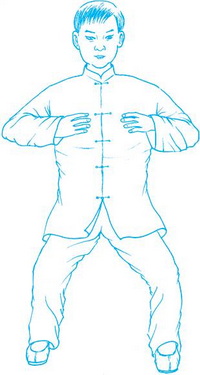
三圆式 【sān yuán shì】
站桩功的一种。三圆指站桩时足圆、臂圆、手圆。
- True (Genuine) Qi
It is a key component of qi of the human body. It can be ① a component of qi after birth. ② yuan-primordial qi. ③ the ability of the body to defend against pathogenic factors.
真气 【zhēn qì】
人体之“气”的一个重要组成部分。① 指后天之气的组成部分。② 指元气。③ 指人体对致病因素的抵抗能力。
- Unblocking of Qi
Originated in Daoism, it refers to the genuine qi unblocking and connecting Du meridian with Ren meridian during practice of qi flow along the small heavenly circle.
气通 【qì tōng】
源于道家。指习练小周天功到一定火候时,真气冲开任督二脉,在任督二脉中运行的过程。
- Unfixed Hour of Zi (11pm — 1am)
Originated in Daoism, it refers to a moment of genuine qi initiating during the extreme quietness of internal alchemical process.
活子时 【huó zǐ shí】
源于道家。指内丹术中,练功至虚静之时,真气萌动的一刻。
- Unhurried Breathing
Originated in Buddhism, it means that when seated, one calmly and quietly breathes through the nose, and can therefore sense the breathing sounds.
风相 【fēng xiàng】
源于佛家。打坐时鼻中气息出入有声。
- Unity between Human and Nature
A concept in ancient Chinese philosophy, referring to human is connected with nature. It suggests that man shall follow the natural law and be harmonious with the environment.
天人相应 【tiān rén xiāng yìng】
中国古代哲学理论,又称天人相通。指人和自然在本质上是相通的,故一切人事均应顺乎自然规律, 以求达到人与自然和谐相处的状态。
- Unity of Three Regulations
This refers to a high level of united body, breathing and mind during qigong practice.
三调合一 【sān tiáo hé yī】
指练功过程中调身、调息、调心三者融合为一的功夫境界。
- Upper Dan Tian
Originated in Daoism, it is located at the forehead between the eyebrows (3 cun interior). It was first recorded in the inner chapter of Terrestrial Truth, Book of the Master Who Embraces Simplicity (Bao Pu Zi Di Zhen Pian), ‘It is located between the eyebrows. One cun interior is called Ming Tang, 2 cun interior Dong Fang and 3 cun interior upper Dan Tian’.
上丹田 【shàng dān tián】
源于道家。位于在两眉之间入内三寸。最初见于《抱朴子· 地真篇》:“在人两眉间,却行一寸为明堂。二寸为洞房,三寸为上丹田也。”
- Visualization
Originated in Buddhism, it refers to see things, truth, principles, and affections with a positive mindset.
观 【guān】
源于佛家。指以正慧观察一切事、理、物、情。
- Wall-gazing
Originated in Buddhism, it’s commonly known as wall facing (miàn bì), referring to a meditative state without any distracting thoughts that the mind is as quiet as unmovable wall.
壁观 【bì guān】
源于佛家。又称面壁静观。指练功入静至杂念不起,心静如壁。
- Water-Fire Coordination
Water and fire here refer to essential qi of the heart and kidney. The last two words ‘Ji Ji’ is the name of hexagram 63, literally means ‘having crossed the river’, which often refers to a mission or a task will be accomplished, suggesting success or a happy ending.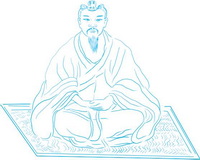
水火既济 【shuǐ huǒ jìjì】
又称水火相交。水火分别指肾、心的精气。既济,原为六十四卦之一。言其水火相交,事既成也。
- Wei Lǘ Pass
One of the three passes, also known as the tailbone or coccygeal pillar. Its upper end connects with the sacrum. Its lower end is posterior and superior to the anus. This pass is close to the point Changqiang (DU 1).
尾闾关 【wěi lǘ guān】
三关之一。又称骶端、厥骨、穷骨,俗称尾桩。在脊椎骨的最下段,上连骶骨,下端游离,在肛门的后上方,该处有长强穴。
- Yellow Court
Originated in Daoism, it refers to a specific body part. ① The center of the brain, heart and spleen. According to commentaries of the Internal Illumination of the Yellow Court Scripture (Huang Ting Nei Jing Jing) by Liang Qiu-zi, ‘Yellow is the color corresponding to the position of center; Court refers to the center of four directions. Externally, the ‘yellow court’ represents the center of heaven, human and earth. Internally, the ‘yellow court’ represents the center of the brain, heart and spleen’. ② an aperture of the body. ③ central position of the five-zang organs (heart, liver, spleen, lung and kidney). ④ the Dan Tian, anterior to the kidney and posterior to the navel; ⑤ no fixed locations (exist only in a name).
黄庭 【huáng tíng】
源于道家。指人体内的一个特定部位,具体位置有几种说法:① 指脑中、心中、脾中。《黄庭内景经》梁丘子注:“黄者,中之色也;庭者,四方之中也。外指事,即天中、人中、地中;内指事,即脑中、心中、脾中。”② 指人体中的虚空窍。③ 指五脏中间的地方。④ 指脐后肾前,即丹田。⑤ 无具体的位置,有名无实。
- Yin-Yang
Yin and yang is a pair of concepts in ancient Chinese philosophy. Originally yin and yang simply refer to the sunny or shady sides of the sunlight. The sunny side is yang, whereas the shady side is yin. Later they were extended to represent cold, heat, upward, downward, left, right, interior, exterior, motion and stillness, etc. Through long-term observation of the nature, ancient thinkers explained natural phenomena using yin-yang opposition and their dynamic waxing and waning, which are inherent to all things. The Dao De Jing (Lao Zi) states, ‘all things bear yin and embrace yang’. They further believed the yin-yang opposition and dynamic waxing and waning are fundamental universal law, as stated in the Commentaries on Book of Changes (Yi Zhuan), ‘the interactions between yin and yang is called the Dao’.
阴阳 【yīn yáng】
中国古代哲学的一对范畴。阴阳的最初涵义是很朴素的,指日光的向背,向日为阳,背日为阴,后来引申为气候的寒暖,方位的上下、左右、内 外,运动状态的躁动和宁静等。古代思想家看到一 切现象都有正反两方面,就用阴阳这个概念来解释 自然界两种对立和相互消长的物质势力,并认为阴 阳的对立和消长是事物本身所固有的,如《老子》: “万物负阴而抱阳”;进而认为阴阳的对立和消长是宇宙的基本规律,如《易传》:“一阴一阳之谓道。”
- Yu Zhen Pass
One of the three passes in the occiput (Yu Zhen literally means Jade Pillow). Location: slightly below the point Yuzhen (BL 9) and in between bilateral Fengchi (GB 20). It is the last pass along the Du meridian that the internal qi has to overcome.
玉枕关 【yù zhěn guān】
三关之一。在后脑部,仰卧时后脑着枕处,在玉枕穴之稍下,两侧风池穴之间,是内气沿督脉上行时必须冲开的最后一个关口。
- Yuan-Primordial Essence
Originated in Daoism, it refers to ① essential qi inherited from one’s parents. ② pre-natal essence. In Chinese texts, the term ‘yuan jing’ was first seen in the Kinship of the Three, in Accordance with the Book of Changes (Zhou Yi Can Tong Qi) and the Mystery-Uncovering Writings of Zi Qing (another name of Bai Yu-chan, a famous Daoist scholar and the founder of the Southern Lineage of the Golden Elixir Sect) (Zi Qing Zhi Xuan Ji), ‘the yuan-primordial essence is not generated from sexual intercourse, but rooted in one’s parents before birth’. Consequently, yuan-primordial essence is intangible generator of tangible essence after birth’.
元精 【yuán jīng】
源于道家。① 禀受于父母的精气。② 来自先天,或称先天之精。《周易参同契》:“元精流布,因炁托初。”。《紫清指玄集》:“其精不是交感精”,而是“根于父母未生前”。所以元精是一种无形的精气,是化生后天形质之精的母气。
- Yuan-Primordial Qi
Originated in Daoism, it refers to ① innate or prenatal qi from one’s parents. ② one form of pre-heaven qi beyond time and space in ancient philosophy.
元气 【yuán qì】
源于道家。① 指禀受于父母的先天之气。② 在古代哲学中,指超越时空的先天一气。
- Yuan-Primordial Spirit
Originated in Daoism, it’s also called Yuan-primordial or inherent nature. According to the Secret Writings transmitted by the Immortal Qing Hua (Qing Hua Mi Wen) by Zhang Boduan in the Song dynasty (960-1279), ‘what we call the yuan-primordial spirit is like innate light of inspiration’.
元神 【yuán shén】
源于道家。又称元性,或称先天之性。张伯端《青华秘文》:“元神者,乃先天以来一点灵光也。”

